Portugal is home to an abundance of beautiful birds and is a paradise for birdwatchers. With a wide variety of habitats, including wetlands, forests, and mountains, Portugal offers an opportunity to observe hundreds of species of birds.
From the colorful Azure-winged Magpie to the captivating Little Bustard, Portugal’s birds are a delight to behold. Join us as we explore the fascinating world of Portugal’s birds, from their behaviors and habitats to their conservation efforts.
1. Eurasian Collared Dove
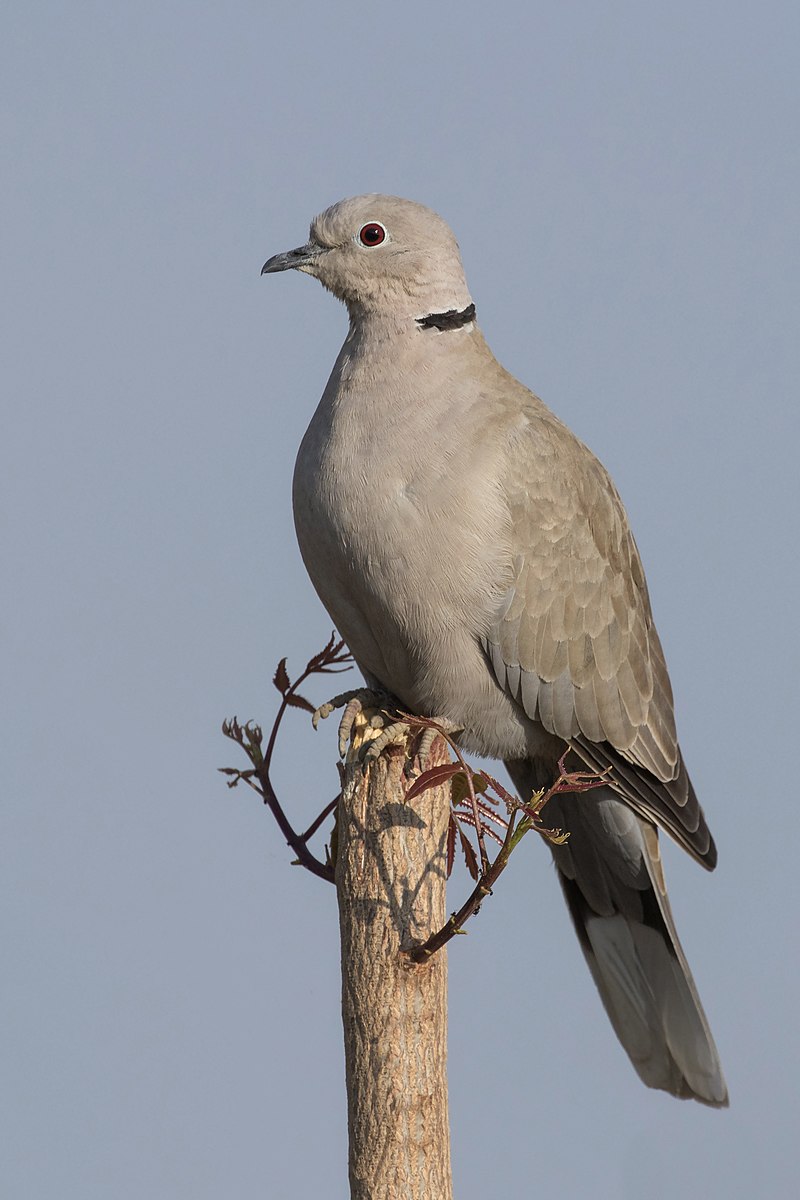
The Eurasian collared dove is a species of bird native to Europe and Asia, with its range expanding through introduction in Japan, North America, and islands in the Caribbean.
It has become so widespread that it is listed as Least Concern on the IUCN Red List. The scientific name for this bird was proposed by Hungarian naturalist Imre Frivaldsz – Columba decaocto.
This beautiful creature typically measures between 33-37 cm from tip to tail feathers, displaying an overall greyish brown plumage; they also have distinctive black half collar around their neck which gives them their common name.
These birds are mainly found inhabiting open woodlands or agricultural lands near human settlements where there’s plenty of food available such as grain fields or gardens where fruits can be eaten off trees.
With a vast global population trend increasing steadily each year these birds make great additions to many backyards throughout the world.
Scientific classification:
| Kingdom | Animalia |
| Phylum | Chordata |
| Class | Aves |
| Order | Columbiformes |
| Family | Columbidae |
| Genus | Streptopelia |
| Species | S. decaocto |
2. Black-Winged Stilt
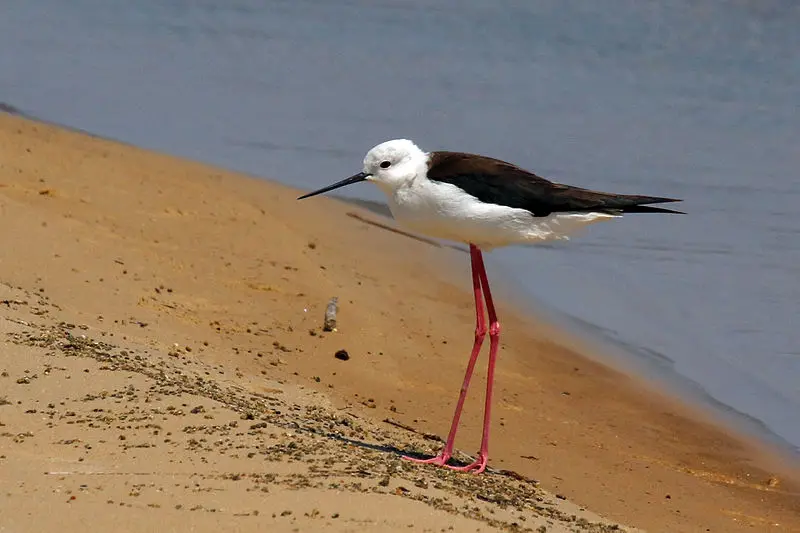
The Black-winged Stilt is a wading bird that belongs to the avocet and stilt family. It has very long legs, making it well adapted for standing in shallow water while searching for food like small fish and insects.
Its scientific name Himantopus himantopus can be applied either to one cosmopolitan species or the form found across Europe, Asia and Africa which equals its nominate group.
Generally this species is black on top with an all white underside but it also features red eyes with a thin white ring around each one as well as black wings flecked with white feathers towards the tips of their wings.
Scientific classification:
| Kingdom | Animalia |
| Phylum | Chordata |
| Class | Aves |
| Order | Charadriiformes |
| Family | Recurvirostridae |
| Genus | Himantopus |
| Species | H. himantopus |
3. White Stork
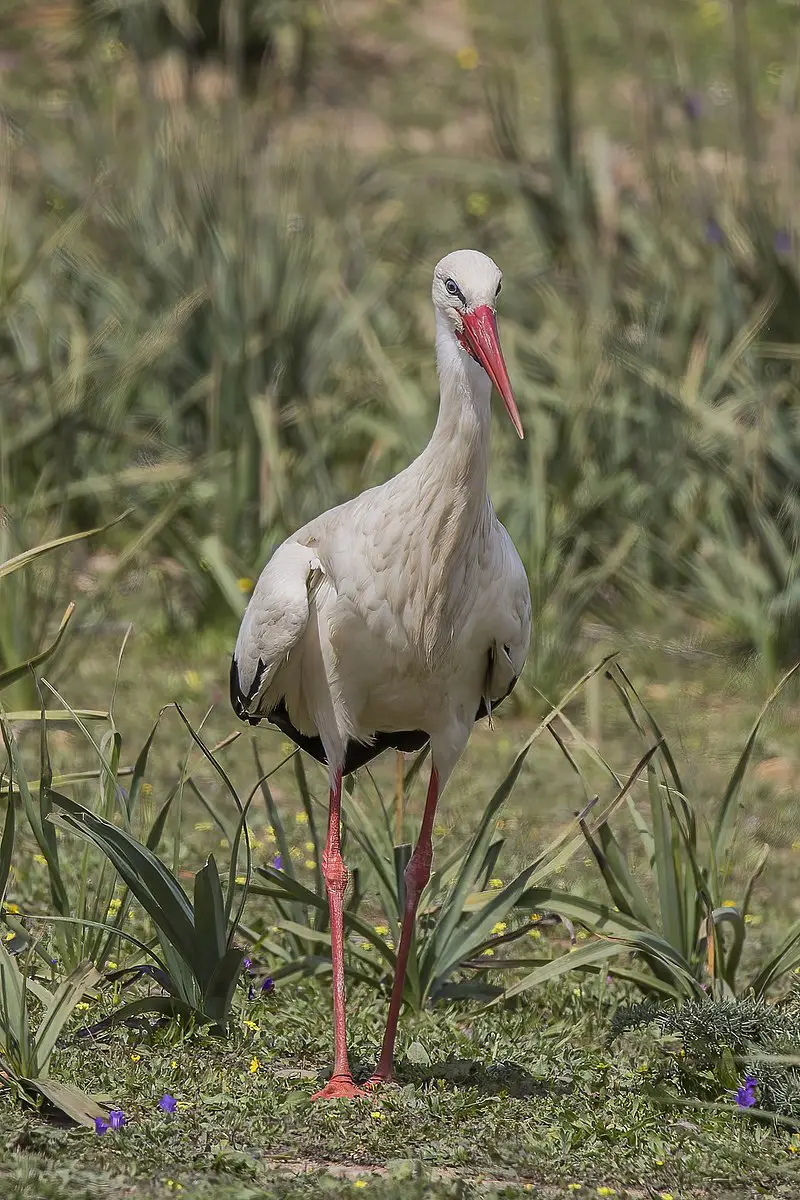
The White Stork is a majestic bird found in Europe, with white plumage and black wings. It has long slender legs and beaks that are usually bright red in color.
The average adult stands around 100 – 115 cm tall from beak to tail tip, while its wing span can reach up to 155-215 cm wide. There are two subspecies of the White Stork which differ slightly by size.
They feed on small animals such as frogs, fish or insects and nest near human dwellings due to the abundance of food available there; they also build nests atop chimneys or roofs when given the chance.
These birds have been revered for centuries as symbols of fertility because their return each spring often coincides with an increase in births among humans living nearby – something superstitious people take great note of.
Scientific classification:
| Kingdom | Animalia |
| Phylum | Chordata |
| Class | Aves |
| Order | Ciconiiformes |
| Family | Ciconiidae |
| Genus | Ciconia |
| Species | C. ciconia |
4. Great Bustard
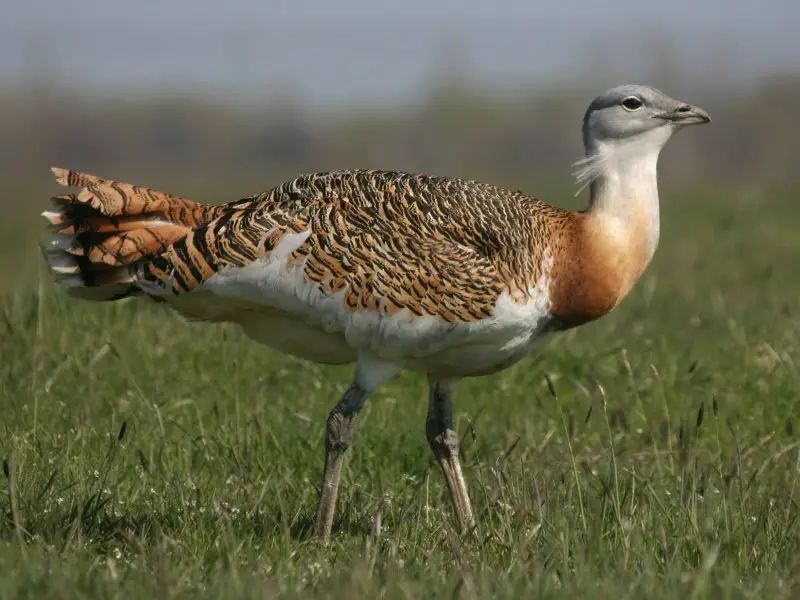
The Great Bustard is a large bird found in open grasslands and farmland across Europe, Central Asia and northern Morocco.
It has a distinctive appearance – its feathers are grey-brown with white below the neck while its head is dark brown.
The species was listed as Vulnerable on the IUCN Red List in 1996 due to population declines caused by habitat loss, overhunting and illegal trade of eggs or chicks.
Conservation efforts provide hope for this majestic creature’s future – some European countries have reintroduced them back into their native habitats through captive breeding programs.
There’s no doubt that we must protect these beautiful birds if they’re to continue soaring majestically above our landscapes for years to come.
Scientific classification:
| Kingdom | Animalia |
| Phylum | Chordata |
| Class | Aves |
| Order | Otidiformes |
| Family | Otididae |
| Genus | Otis |
| Species | O. tarda |
5. Hen Harrier
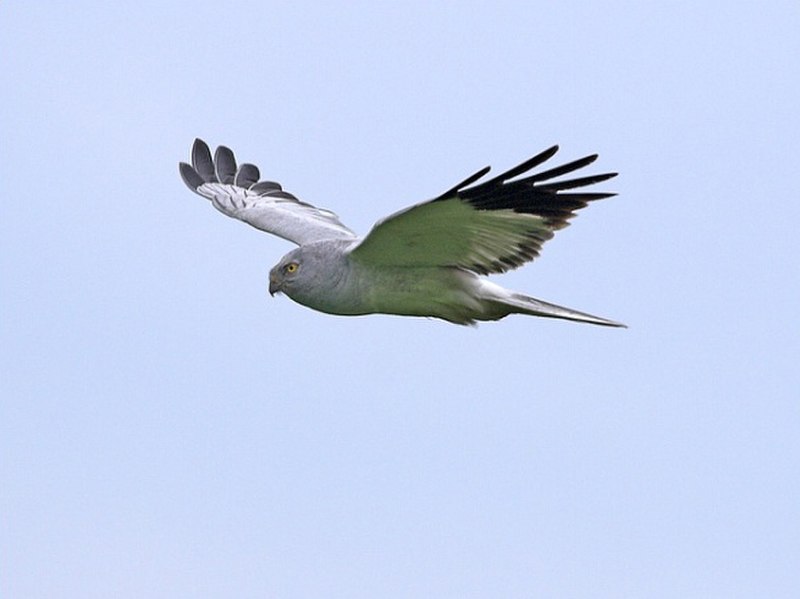
The Hen Harrier is a majestic bird of prey that breeds across Eurasia. It has the distinction of being one of the few birds to hunt free-roaming poultry, hence its name.
During winter months it migrates southwards towards Southern Europe and temperate Asia in search for more favourable climates than what can be found in its northern nesting grounds.
In milder regions like Great Britain and France, these raptors may remain year round where they are often spotted hunting over higher ground areas such as meadows or moorlands.
The hen harrier is an incredible sight with its dark wingspan soaring through the air while searching for small mammals or reptiles on which it feeds upon.
Scientific classification:
| Kingdom | Animalia |
| Phylum | Chordata |
| Class | Aves |
| Order | Accipitriformes |
| Family | Accipitridae |
| Genus | Circus |
| Species | C. cyaneus |
Also Featured In: Most Common Scotland Birds, Common Cornwall Birds
6. Black-Winged Kite
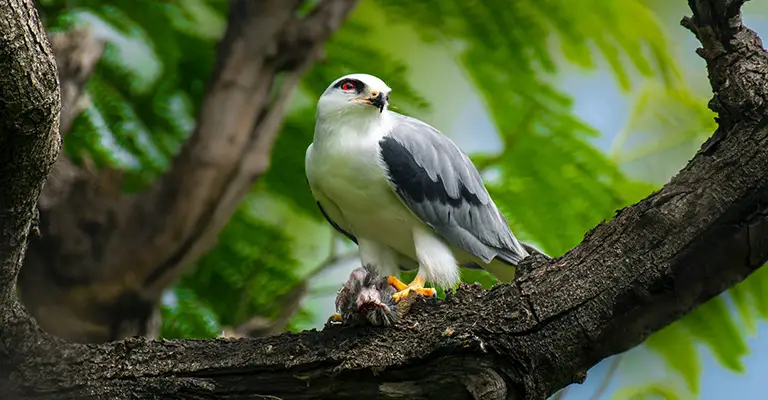
The Black-winged Kite is a small, diurnal bird of prey in the Accipitridae family. It can be found throughout Palearctic and Afrotropical regions.
This species stands out from other birds of prey due to its unique ability to hover over open grasslands like kestrels do.
Its wings are black with white patches on them while its body has gray feathers, giving it a distinct look from the rest of the accipiters.
The underside is mostly white with some barring near the tail area that helps distinguish this species from others.
They feed mainly on insects but will also eat rodents, lizards and even snakes if they come across one.
Because these birds hunt during daylight hours, their diet changes as time passes by – making them quite adaptive hunters.
Scientific classification:
| Kingdom | Animalia |
| Phylum | Chordata |
| Class | Aves |
| Order | Accipitriformes |
| Family | Accipitridae |
| Genus | Elanus |
| Species | E. caeruleus |
7. Western Swamphen
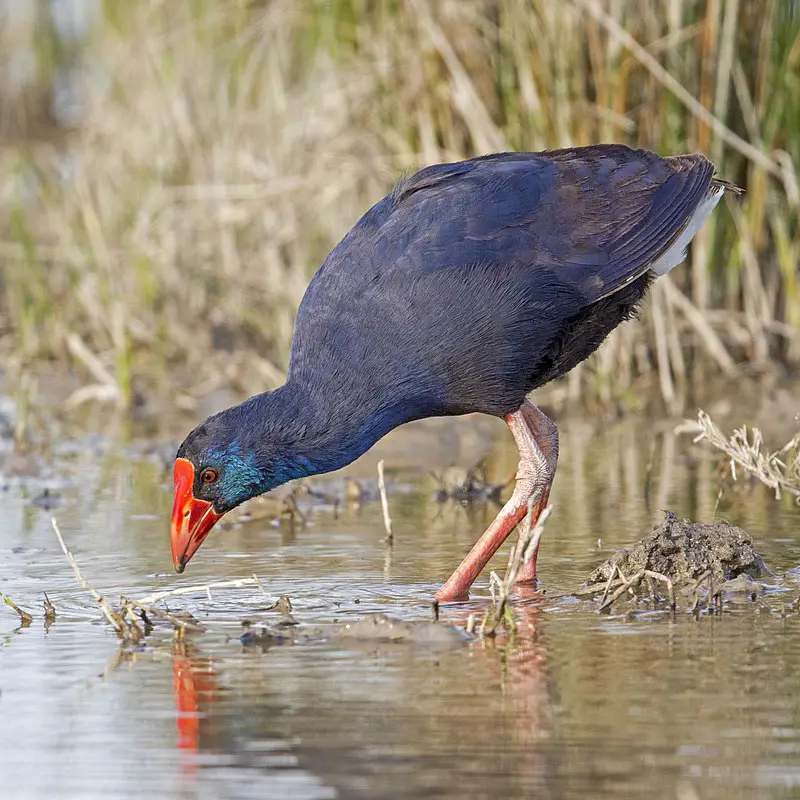
The Western Swamphen is a species of swamphen belonging to the Rallidae family. It has an impressive appearance: its bright plumage, long legs and large red bill make it easily recognizable.
Its French name ‘talève sultane’ gives it the nickname of ‘Sultana Bird’. It is typically chicken-sized but can be slightly larger in some areas.
The Western Swamphen’s diet consists mainly of aquatic vegetation such as pondweeds, watercress and rushes, along with small invertebrates like snails, insects and larvae.
Breeding usually occurs between spring and summer when mating pairs construct nests made from reed stems near shallow waters or marshlands which they defend fiercely against intruders.
The male also performs courtship displays by raising his feathers while bobbing up and down in front of potential mates to attract them into their territories for breeding purposes.
Scientific classification:
| Kingdom | Animalia |
| Phylum | Chordata |
| Class | Aves |
| Order | Gruiformes |
| Family | Rallidae |
| Genus | Porphyrio |
| Species | P. porphyrio |
8. Spanish Imperial Eagle
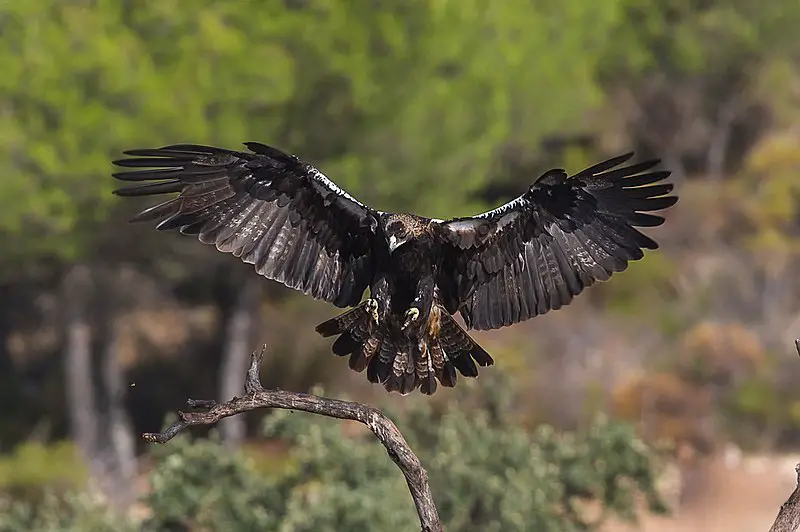
The Spanish imperial eagle is a majestic species of bird native to the Iberian Peninsula. Also known as Adalbert’s Eagle, it was named after Prince Adalbert of Bavaria and can be identified by its distinct white-shouldered “epaulettes”.
This stunning raptor typically features dark brown plumage with light golden feathers on their chest and wings, along with bright yellow eyes and legs.
Measuring up to 75 cm in length with a wingspan of around 1.8 m, these birds are powerful predators equipped for hunting small mammals or carrion found within their forest habitat.
Although formerly considered a subspecies of the Golden eagle due to similarities in size and appearance, research has since proven that this unique species deserves full recognition on its own merits.
Scientific classification:
| Kingdom | Animalia |
| Phylum | Chordata |
| Class | Aves |
| Order | Accipitriformes |
| Family | Accipitridae |
| Genus | Aquila |
| Species | A. adalberti |
9. Little Bustard
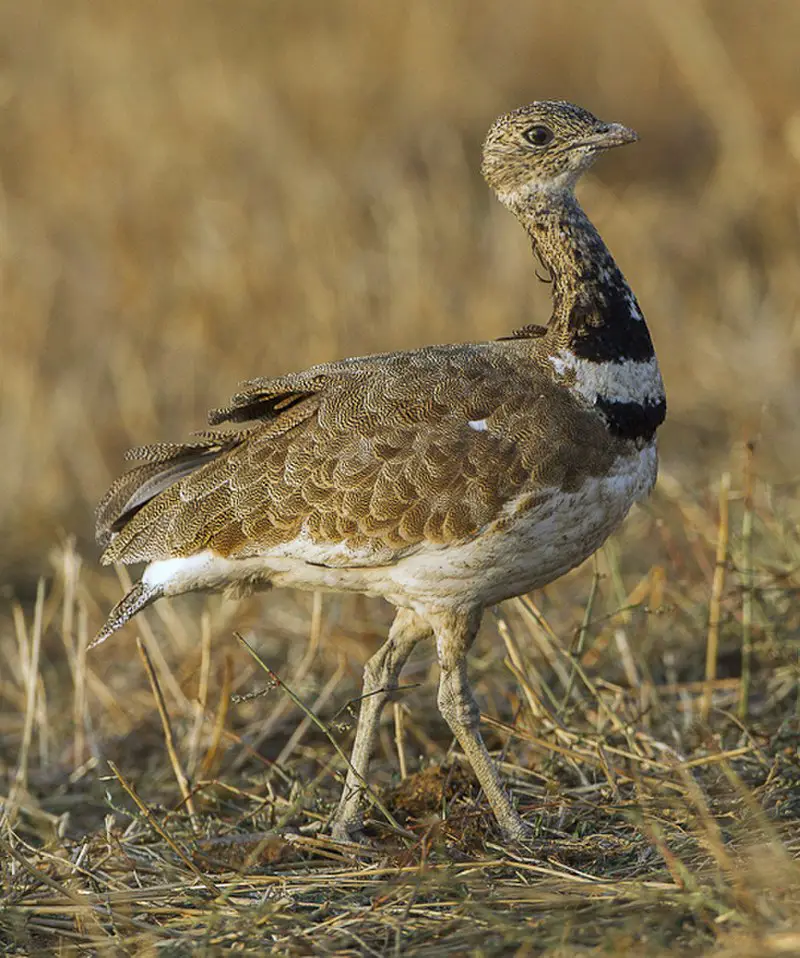
The Little Bustard (Tetrax tetrax) is a bird belonging to the bustard family. It can be found in Southern Europe and Western/Central Asia, with some populations migrating south during wintertime.
This species has an ancient Greek genus name meaning ‘gamebird’, which was mentioned by Aristophanes and other authors of antiquity.
Physically, this bird features mottled feathers that range from greyish-brown on its upperparts to light sandy colors underneath.
Moreover, it also showcases black stripes above each eye as well as dark barring on its wings and tailfeathers.
The little bustard typically feeds off insects while walking or running through open plains but will occasionally nest near cultivated fields too.
All things considered, we should definitely appreciate these birds for their beauty and resilience.
Scientific classification:
| Kingdom | Animalia |
| Phylum | Chordata |
| Class | Aves |
| Order | Otidiformes |
| Family | Otididae |
| Genus | Tetrax T. Forster, 1817 |
| Species | T. tetrax |
10. Northern Gannet
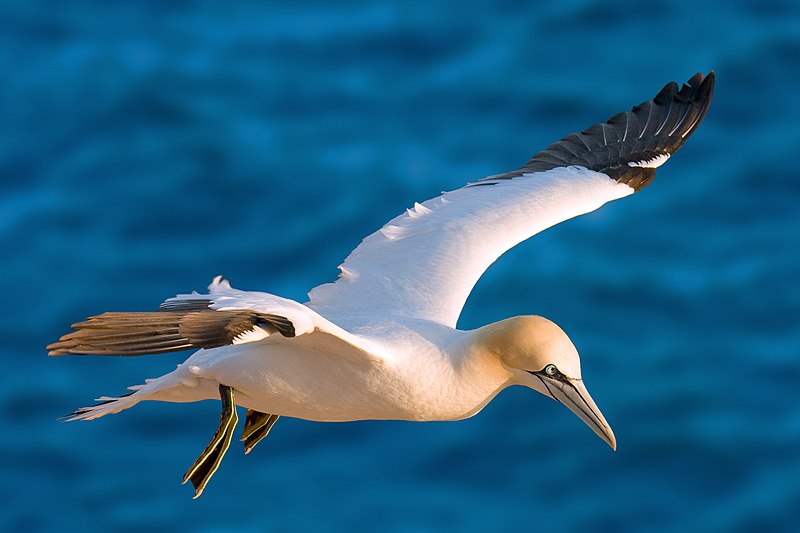
The Northern Gannet is the largest species of seabird in the northern Atlantic, with a white body and long neck.
It has yellowish head feathers and black tipped wings that can reach up to 6 feet across when fully extended.
The beak is large and orange-yellow in color. This bird breeds along western Europe’s coasts as well as northeastern North America.
They forage for fish by plunging into the sea from high above, making them an impressive sight to behold on any given day.
Their diet consists mainly of herring, mackerels or sand eels which they catch midair after diving at speeds reaching over 100 miles per hour.
With their striking features these birds are truly majestic creatures that have been around since prehistoric times – a testament to their hardiness and adaptability.
Scientific classification:
| Kingdom | Animalia |
| Phylum | Chordata |
| Class | Aves |
| Order | Suliformes |
| Family | Sulidae |
| Genus | Morus |
| Species | M. bassanus |
Also Featured In: Birds You’ll Find in the Sea, Italian Birds You Should Know
11. Sanderling
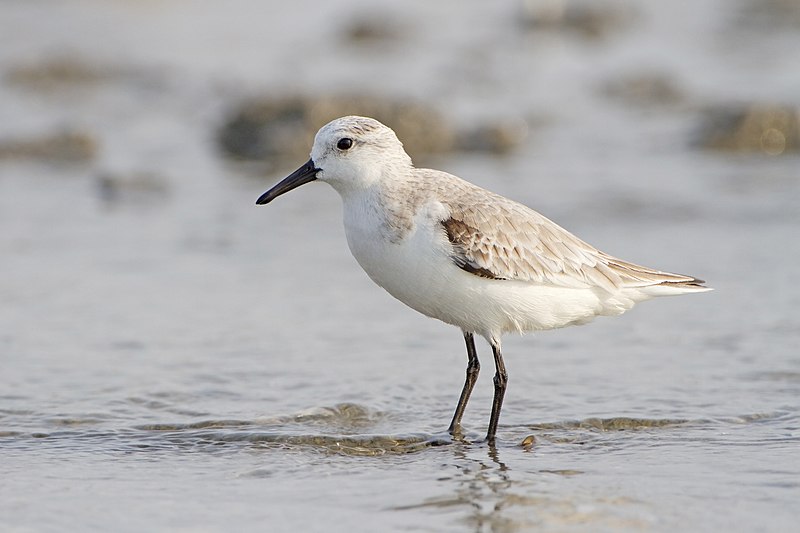
The Sanderling is a small wading bird that can be found in the Arctic region. Its name comes from Old English, meaning “sand-ploughman”. It has grey feathers and light legs which give it its distinct white coloration.
During summer breeding months, they are known to travel great distances – some wintering as far south as South America or Southern Africa. They typically feed on crustaceans such as shrimp and mollusks along coastal shores.
The Sanderling is an important species to watch out for because of their long migratory patterns and sensitivity to environmental change; if there’s trouble with this species then other birds may also be affected.
Scientific classification:
| Kingdom | Animalia |
| Phylum | Chordata |
| Class | Aves |
| Order | Charadriiformes |
| Family | Scolopacidae |
| Genus | Calidris |
| Species | C. alba |
12. Collared Pratincole
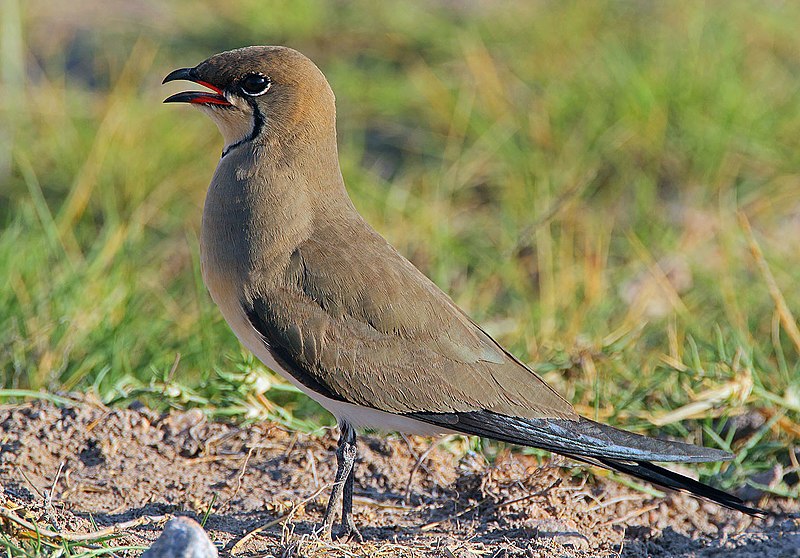
The Collared Pratincole is a small wader bird native to the Old World. It has distinctive long wings that are reddish-brown in color and have white tips, which give it its name.
Its body is mostly dark brown with some lighter spots along its back and sides. The bill of this species is short and pointed, making it a specialist for eating insects from mudflats or shallow waters.
During breeding season, they form loud flocks that can be heard from miles away when calling out their distinct song; during non-breeding time they disperse into smaller groups while searching for food sources in drier regions such as grasslands or fields.
This species relies heavily on open habitats where there are plenty of places to hunt for food throughout the year.
Scientific classification:
| Kingdom | Animalia |
| Phylum | Chordata |
| Class | Aves |
| Order | Charadriiformes |
| Family | Glareolidae |
| Genus | Glareola |
| Species | G. pratincola |
13. Red-Legged Partridge
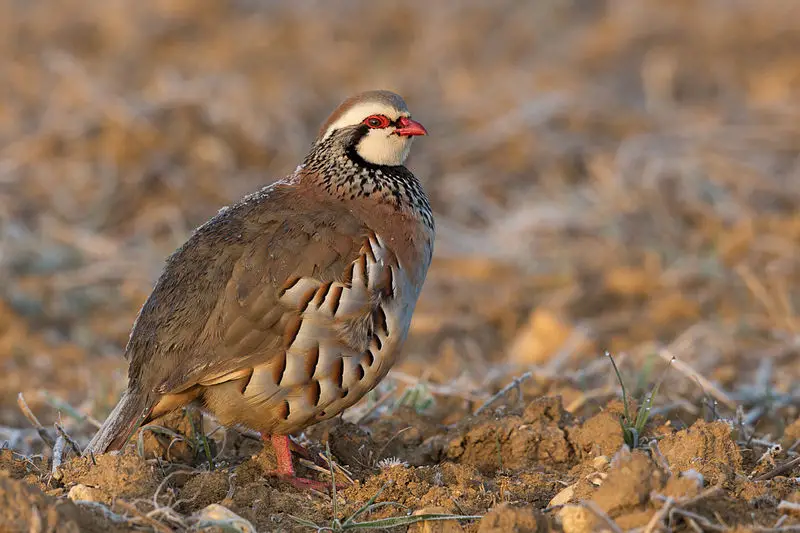
The Red-legged Partridge is a small gamebird belonging to the pheasant family. It has an oval shape with its back being light brown and breast grey in color.
Its Latin name, Alectoris rufa, translates as “red farmyard chicken”. These birds are found throughout Europe and parts of western Asia where they inhabit open grasslands or cultivated fields.
They feed primarily on seeds but also consume insects which they find while scratching through soil for food.
The male red-legged partridges are slightly larger than females and have distinctive black patches on their faces along with white spotting across their wings and tail feathers during breeding season.
Despite having no legal protection, these birds remain popular among hunters due to their attractive plumage combined with elusive nature making them challenging prey animals for sporting pursuits.
Scientific classification:
| Kingdom | Animalia |
| Phylum | Chordata |
| Class | Aves |
| Order | Galliformes |
| Family | Phasianidae |
| Genus | Alectoris |
| Species | A. rufa |
Also Featured In: Common Birds of Portugal,
14. Eurasian Griffon Vulture
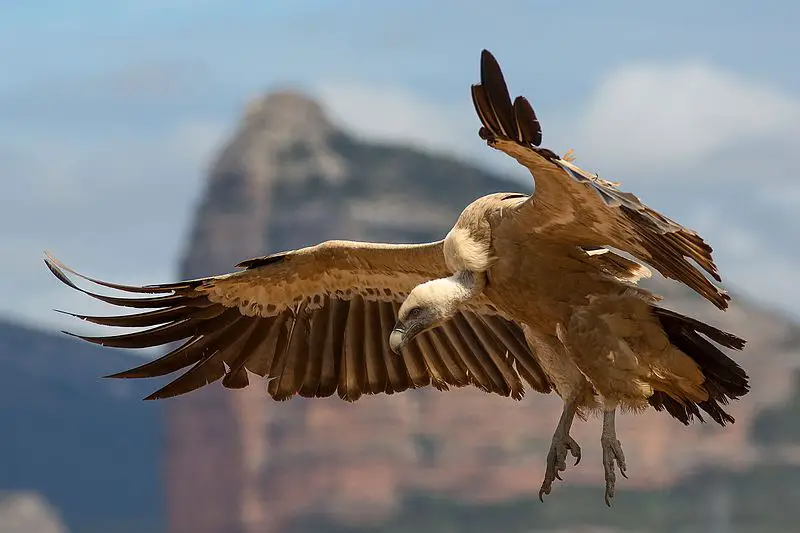
The Eurasian griffon vulture (Gyps fulvus) is an impressive Old World bird of prey. It has a wingspan that can reach up to 4.8 meters and is usually between 93-122 cm in length.
Its body feathers are dark brown with lighter areas on its head, chest and wings while the underside of its tail and flight feathers are white.
This species feeds primarily on carrion but will also scavenge for food when necessary; they have been known to form large groups in order to increase their chances of finding a meal or being able to steal one from another group member.
The Griffon Vulture’s natural habitat ranges across Europe, Asia Minor, North Africa into parts of India as well as some islands off the coast such as Crete and Cyprus.
They nest fairly high up either alone or in small colonies – often using old nests built by other birds like eagles or storks to save time.
Scientific classification:
| Kingdom | Animalia |
| Phylum | Chordata |
| Class | Aves |
| Order | Accipitriformes |
| Family | Accipitridae |
| Genus | Gyps |
| Species | G. fulvus |
Also Featured In: Birds that Live in Croatia, Birds You’ll Find in Albania
15. Montagu’s Harrier
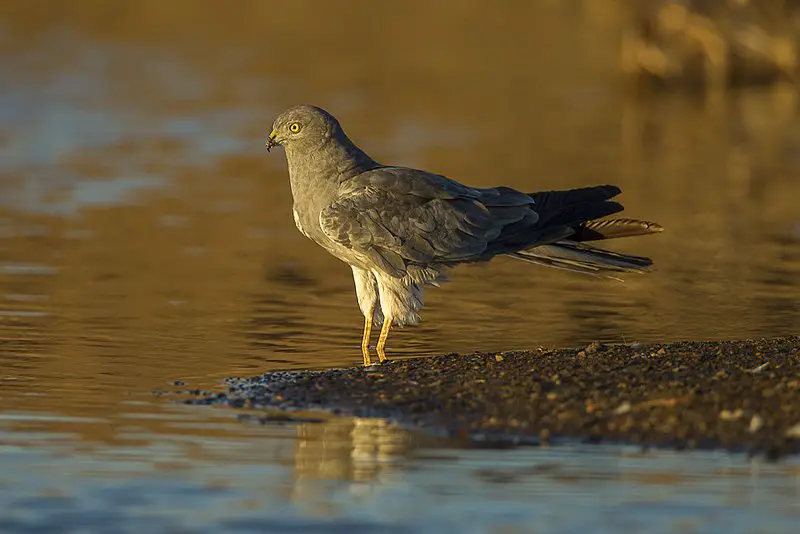
Montagu’s harrier is a migratory bird of prey belonging to the Harrier family. Named after British naturalist George Montagu, it was first formally described by Swedish naturalist Carl Linnaeus in 1758 under its binomial name Falco pygargus.
The genus Circus was introduced by French naturalis later on for this species. It has dark brown upper parts and white underside with yellow legs and bill.
During breeding season the male shows grey-blue back while female displays more streaked patterned plumage which helps them camouflage well into grasslands environment where they usually hunt rodents, reptiles and small birds as food source during migration period when they are not restricted to nesting areas only.
They are mostly found in Europe but also occasionally seen over North Africa due to their long distance travelling nature making them an interesting part of wildlife diversity around the world.
Scientific classification:
| Kingdom | Animalia |
| Phylum | Chordata |
| Class | Aves |
| Order | Accipitriformes |
| Family | Accipitridae |
| Genus | Circus |
| Species | C. pygargus |
16. Booted Eagle
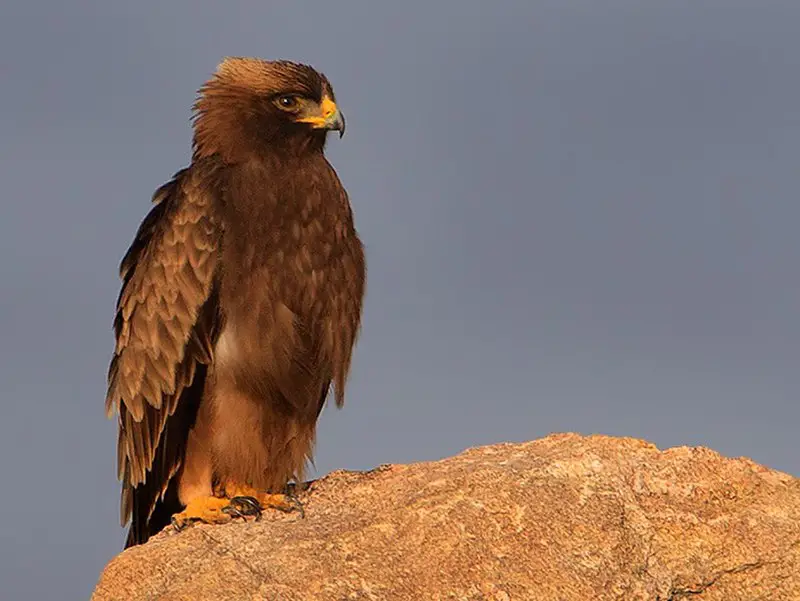
The Booted Eagle is a medium-sized bird of prey, typically found in the Palearctic and southern Asia. During winter months they migrate to Africa and Asia’s tropical regions.
A small population also breeds in south western Africa. It belongs to the Accipitridae family which includes all eagles.
Described formally back in 1780, it has an impressive wingspan reaching up to 1 meter across.
With its black tail feathers contrasting against its brown body plumage with white patches on the underside of their wings when seen from below makes for easy identification amongst other birds of prey during flight or perched atop trees or buildings surveying for potential food sources like rodents, insects and even reptiles at times.
Scientific classification:
| Kingdom | Animalia |
| Phylum | Chordata |
| Class | Aves |
| Order | Accipitriformes |
| Family | Accipitridae |
| Genus | Hieraaetus |
| Species | H. pennatus |
Also Featured In: Most Common Spain Birds, Big Birds that Live in Uganda
17. Bonelli’s Eagle
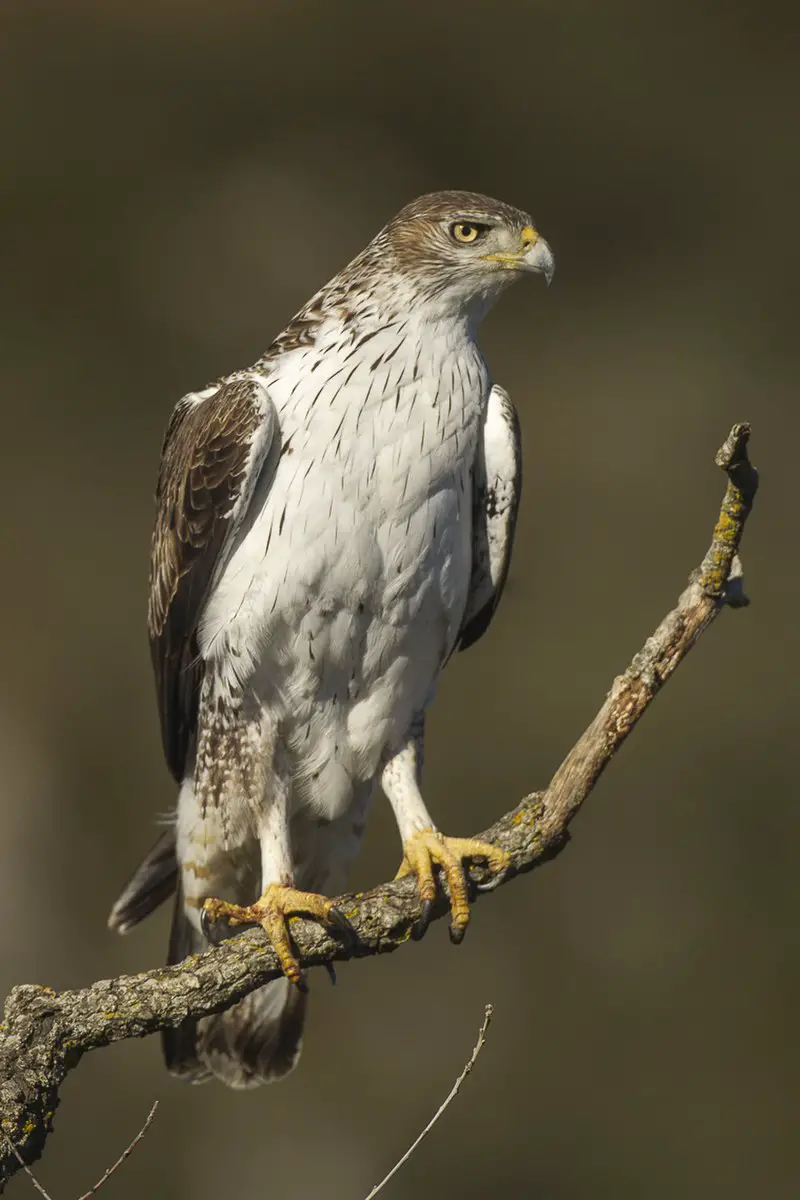
Bonelli’s eagle is a majestic bird of prey, named after the Italian ornithologist and collector Franco Andrea Bonelli. It can be found in parts of Europe, Africa and Asia where it inhabits wooded hillsides or open mountain ranges.
The species has an impressive wingspan that reaches up to 6 feet across. They use their sharp talons to catch small animals such as lizards and rabbits which they hunt from high above the ground.
With its distinctive crestless head, streaked chestnut feathers on its back and white underparts this stunning raptor makes for quite a sight when soaring through the sky.
Scientific classification:
| Kingdom | Animalia |
| Phylum | Chordata |
| Class | Aves |
| Order | Accipitriformes |
| Family | Accipitridae |
| Genus | Aquila |
| Species | A. fasciata |
Also Featured In: Birds that Live in Montenegro, Most Popular Birds in Mallorca
18. Short-Toed Snake Eagle
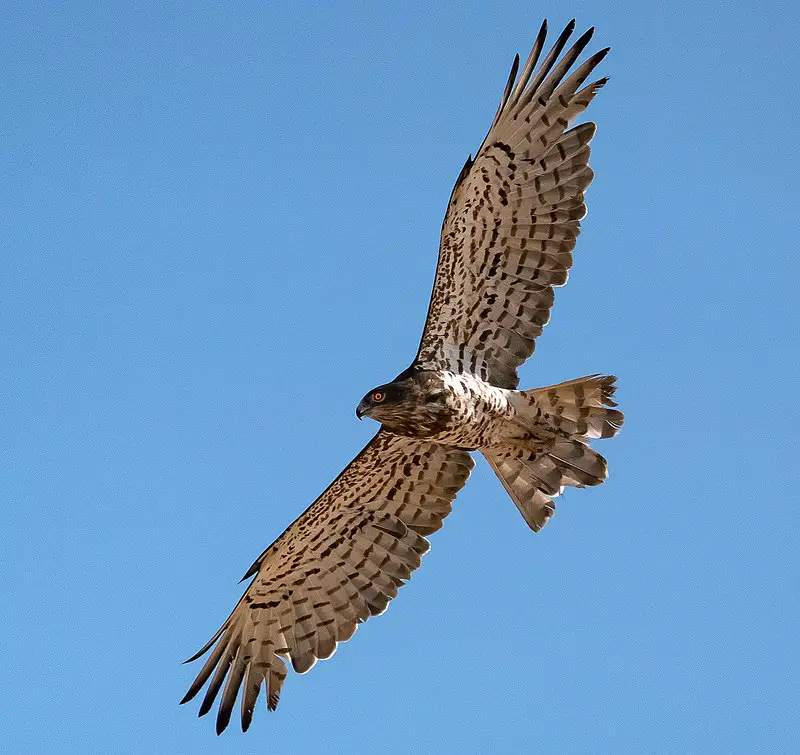
The Short-toed Snake Eagle is a medium sized bird of prey that belongs to the Accipitridae family. It has a wide distribution across Europe, Asia and Africa.
The species name ‘gallicus’ refers to Gallia, which was an ancient region in Western Europe corresponding mostly to what is now France.
This raptor feeds mainly on snakes but also preys upon lizards and small mammals like rodents and bats.
Its diet allows it to thrive even in areas with limited food resources as its main source of nourishment are easily found reptiles.
The short-toed eagle prefers open habitats such as grasslands or steppes where they can hunt more efficiently using their sharp vision combined with agile flight manoeuvres which allow them to quickly snatch up their prey from long distances away.
Scientific classification:
| Kingdom | Animalia |
| Phylum | Chordata |
| Class | Aves |
| Order | Accipitriformes |
| Family | Accipitridae |
| Genus | Circaetus |
| Species | C. gallicus |
Also Featured In: Most Common Romanian Birds, Birds Found in Hungary
19. Little Owl
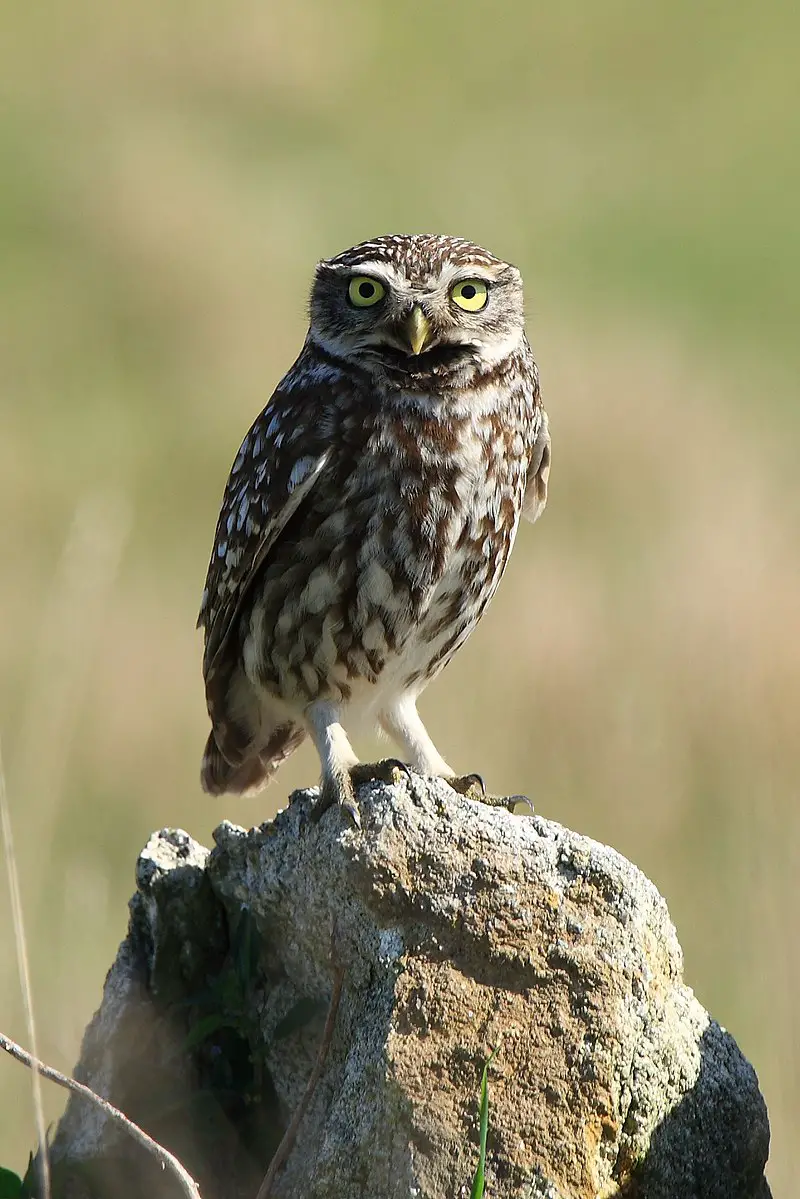
The Little Owl is a fascinating bird that inhabits much of the temperate and warmer parts of Europe, East Asia and North Africa. It’s also known as the “Owl of Athena” or “Owl of Minerva”.
This species was introduced to Britain in late 19th century and New Zealand’s South Island during early 20th century.
They belong to Strigidae family which are true owls with small bodies but large heads along with big eyes that helps them spot prey at night.
These birds feed on insects, earthworms, rodents like mice etc., making them beneficial for controlling pests around agricultural lands.
Besides these benefits they have become an important part in folklore associated with wisdom and knowledge over years due their silent presence near human dwellings after dark hours.
Scientific classification:
| Kingdom | Animalia |
| Phylum | Chordata |
| Class | Aves |
| Order | Strigiformes |
| Family | Strigidae |
| Genus | Athene |
| Species | A. noctua |
20. Little Bittern
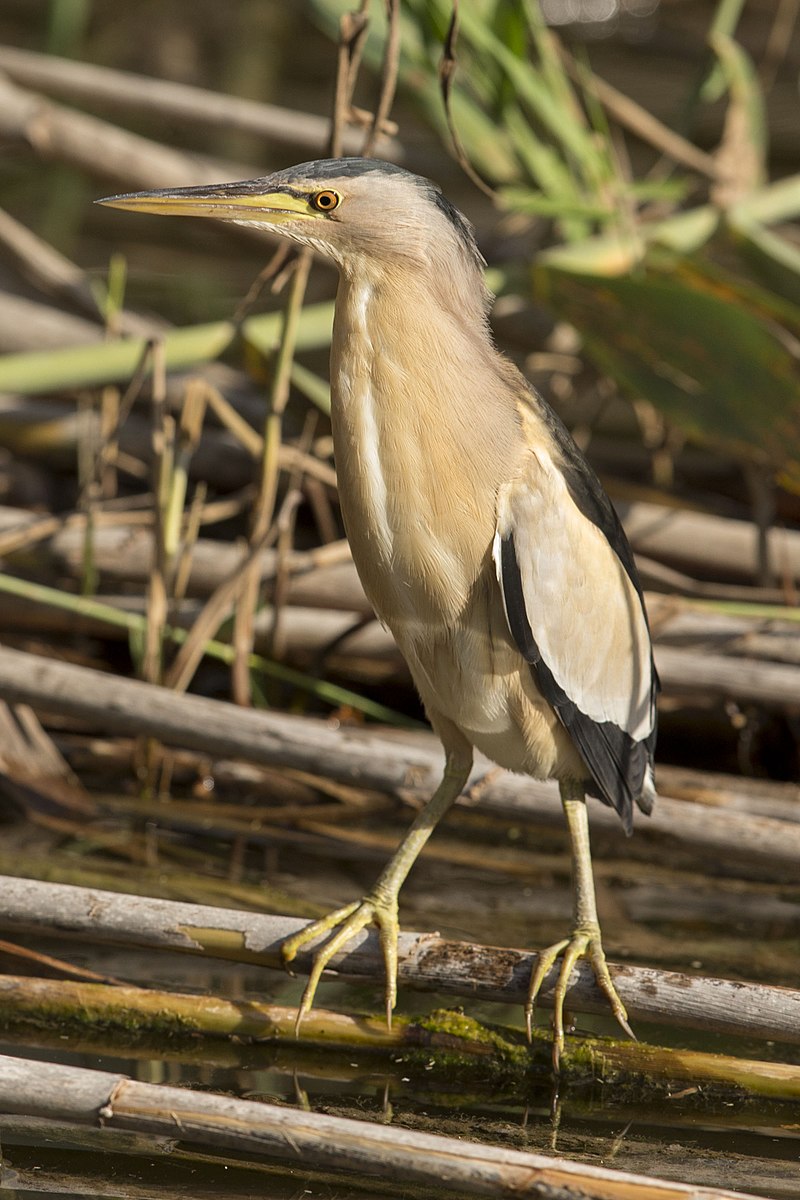
The Little Bittern is a wading bird in the heron family, Ardeidae. Its scientific name Ixobrychus minutus comes from Ancient Greek ixias and Latin for “small” respectively.
It breeds across Africa, central and southern Europe, western and southern Asia as well as Madagascar.
The Little bittern has an orange-brown back with streaks of black while its underside is white with dark stripes running down it sides giving it excellent camouflage to hide amongst reeds or tall grasses near shallow water bodies such as wetlands where they search for food like fish, frogs etc..
They are usually very shy birds but during mating season males make loud croaking calls that can be heard up to 400m away.
These beautiful little creatures have sadly been classified by International Union for Conservation of Nature (IUCN) Red List of Threatened Species due their declining population caused mainly by habitat destruction through agricultural practices or draining of wetland areas which leads to loss if nesting sites putting them at risk.
Scientific classification:
| Kingdom | Animalia |
| Phylum | Chordata |
| Class | Aves |
| Order | Pelecaniformes |
| Family | Ardeidae |
| Genus | Ixobrychus |
| Species | I. minutus |
Also Featured In: Ukrainian Birds You Should Know, Belarus Birds You Should Know
21. Red-Necked Nightjar
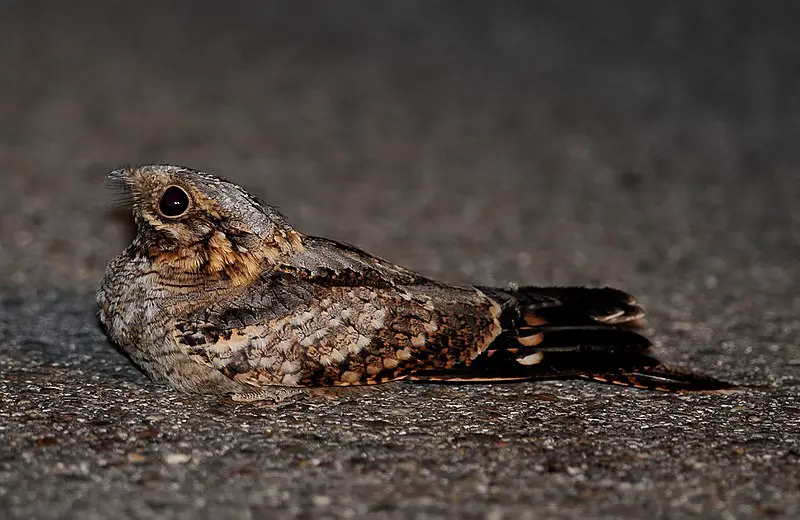
The Red-necked Nightjar is the largest of all nightjars found in Europe. It breeds in Iberia and North Africa, then migrates to tropical West Africa for wintering.
The bird was named based on an old myth that it can suck milk from goats as its scientific name Caprimulgus derived from Latin words ‘capra’ meaning nanny goat and ‘mulgere’ means to milk.
Furthermore, ruficollis refers to its red neck which comes from the Latin word ‘rufus’ meaning red and collum meaning neck respectively.
This nocturnal species has a greyish color body with black barring across wings while white spots located at their primaries make them easy to identify even during daytime flight activities when they search for food such as insects or fruit bats by hovering few feet above ground level before swoop down on prey.
Scientific classification:
| Kingdom | Animalia |
| Phylum | Chordata |
| Class | Aves |
| Order | Caprimulgiformes |
| Family | Caprimulgidae |
| Genus | Caprimulgus |
| Species | C. ruficollis |
22. Black-Headed Gull
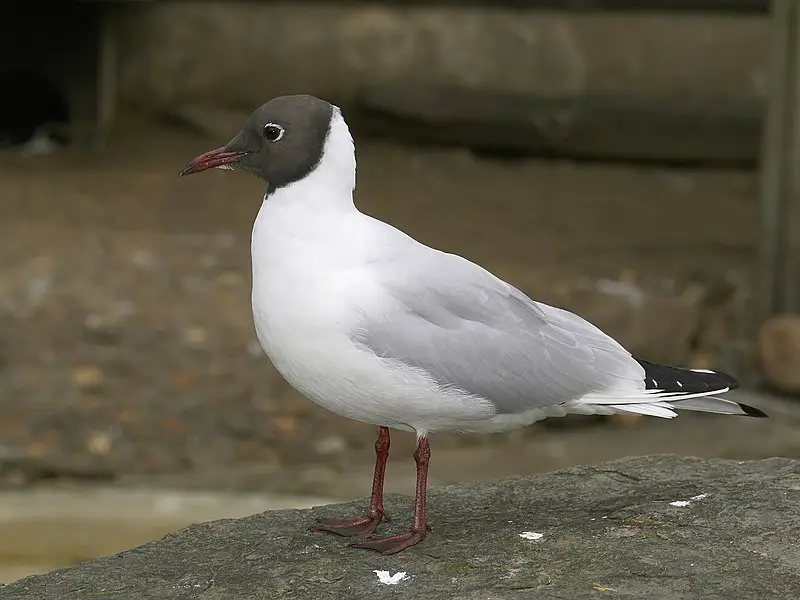
The Black-headed Gull is a small, migratory bird found in much of the Palearctic. It breeds mainly in Europe and coastal eastern Canada but can also be found further west in milder areas.
In North America it’s known as the Common Black-headed Gull.
Its plumage consists of grey on top with white underneath, while its head has a distinctive black cap during breeding season which fades to brown outside of this period.
They are often seen by coastlines or near inland waters where they feed off fish, insects and crustaceans caught either from the surface or underwater depending on their preference at that time.
Scientific classification:
| Kingdom | Animalia |
| Phylum | Chordata |
| Class | Aves |
| Order | Charadriiformes |
| Family | Laridae |
| Genus | Chroicocephalus |
| Species | C. ridibundus |
23. Red Kite
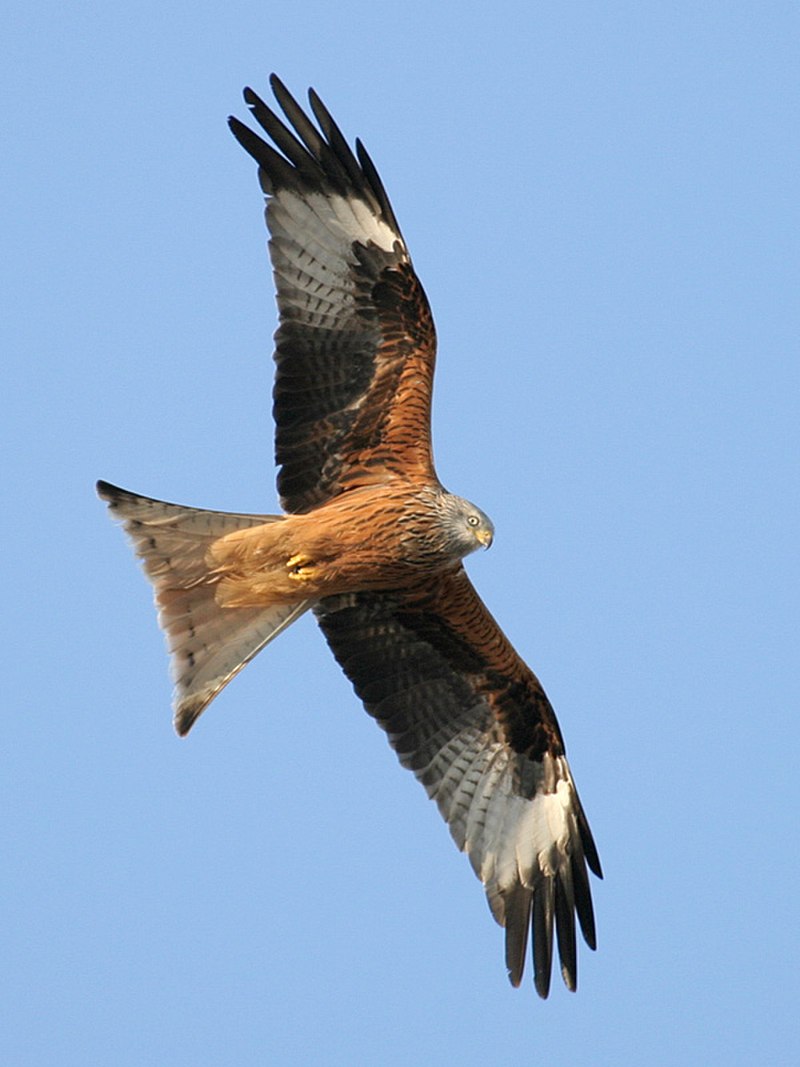
The Red Kite is a magnificent bird of prey, belonging to the family Accipitridae. It can be found in western Europe and northwest Africa where it breeds, while also occurring occasionally in northern Iran.
These birds are medium-large size with wingspans ranging from 125 – 170 cm wide. They have reddish brown plumage on their upperparts and pale gray underneath.
The Red Kite feeds mainly on small mammals, carrion and insects which they hunt for by soaring through the air using thermals to gain altitude before diving down onto its prey.
Furthermore, this species has adapted well to human presence since it often scavenges near roadsides or rubbish dumps as an easy source of food.
All things considered, these majestic creatures make up a beautiful part of our natural environment that should definitely not go unnoticed.
Scientific classification:
| Kingdom | Animalia |
| Phylum | Chordata |
| Class | Aves |
| Order | Accipitriformes |
| Family | Accipitridae |
| Genus | Milvus |
| Species | M. milvus |
24. Eurasian Blue Tit
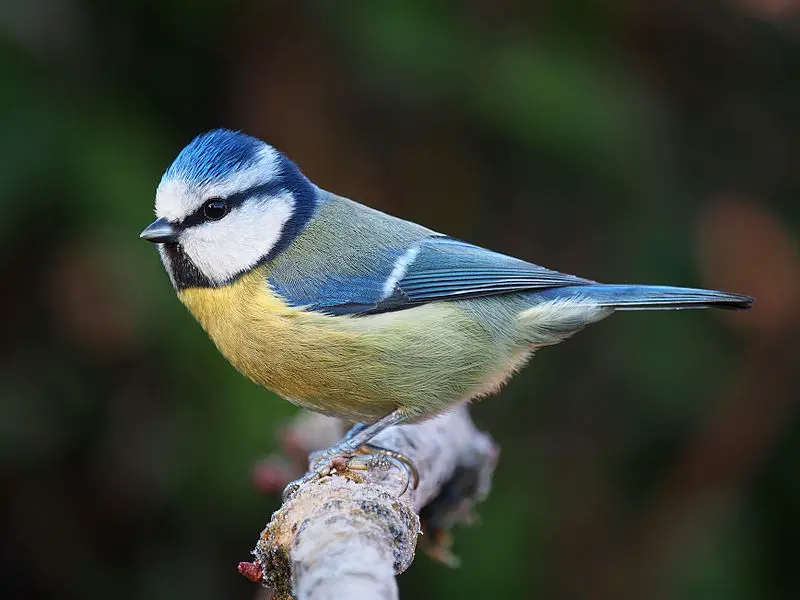
The Eurasian blue tit is a small passerine bird belonging to the Paridae family. Its bright blue and yellow plumage makes it easily recognizable, along with its small size.
They are usually resident birds that do not migrate, living throughout temperate or subarctic Europe and western Palearctic in deciduous woodlands.
These birds breed year-round and are common residents of these areas.
Their diet consists mainly of insects but they also feed on seeds during winter months when insects become scarce.
They can be found both alone or in pairs searching for food amongst trees branches, shrubs, grasses as well as visiting gardens for supplementary food sources such as peanut feeders provided by garden owners.
Scientific classification:
| Kingdom | Animalia |
| Phylum | Chordata |
| Class | Aves |
| Order | Passeriformes |
| Family | Paridae |
| Genus | Cyanistes |
| Species | C. caeruleus |
25. Common Blackbird
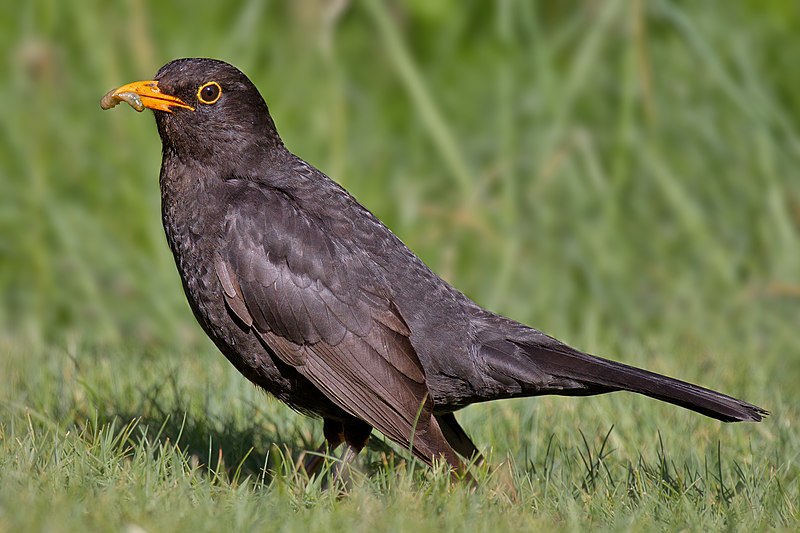
The Common Blackbird is a species of true thrush with the scientific name Turdus merula. Found in Europe, Asiatic Russia and North Africa it has also been introduced to Australia and New Zealand.
The male bird has glossy black plumage while the female’s coloration is more brownish gray.
It is known for its melodious song that can be heard throughout much of the year; typically they are seen alone or in pairs but occasionally form large flocks when food sources become available or during migration periods.
Its diet consists mainly of insects, worms, berries and other fruits as well as some human-provided foods such as bread crumbs or garbage scraps when available.
With its wide distribution range along with ease of adaptation to different habitats this species will likely remain one our most common birds around us.
Scientific classification:
| Kingdom | Animalia |
| Phylum | Chordata |
| Class | Aves |
| Order | Passeriformes |
| Family | Turdidae |
| Genus | Turdus |
| Species | T. merula |
26. Shorebirds
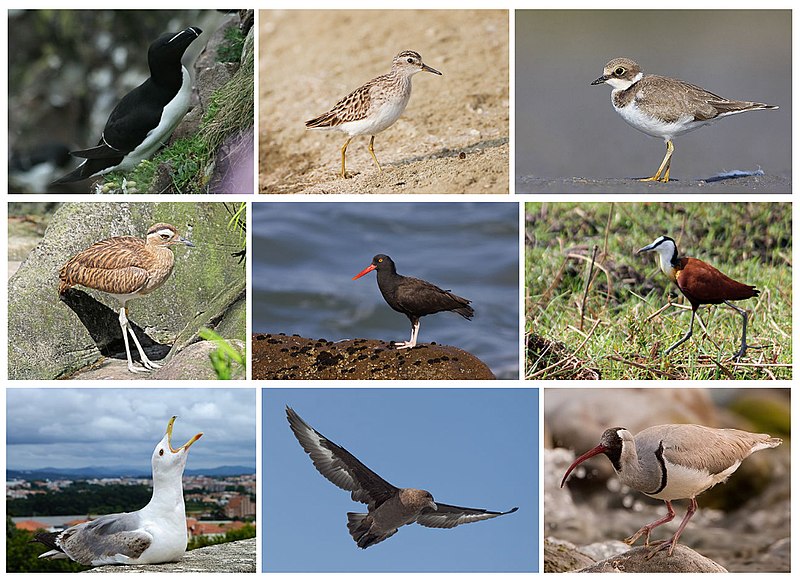
Shorebirds, a diverse group of birds in the Charadriiformes order, are found near water on every continent except Antarctica.
These small to medium-sized birds feed mainly on invertebrates and other small animals but can also be pelagic seabirds or inhabit deserts.
Shorebirds use their long bills to probe mudflats for food like worms and mollusks while some species plunge into the ocean’s depths in search of crustaceans such as crabs and shrimp.
They have strong legs equipped with webbed feet which allow them to move quickly when searching for prey across wetlands, sandbars, beaches and swamps.
Their feathers make them well adapted to life by land or sea due to its hydrophobic nature which helps reduce drag during swimming or flying through windy conditions making it easier for shorebirds survive tough environments around the world.
Scientific classification:
| Kingdom | Animalia |
| Phylum | Chordata |
| Class | Aves |
| Infraclass | Neognathae |
| Clade | Neoaves |
| Clade | Gruimorphae |
| Order | Charadriiformes Huxley, 1867 |
27. Purple Heron
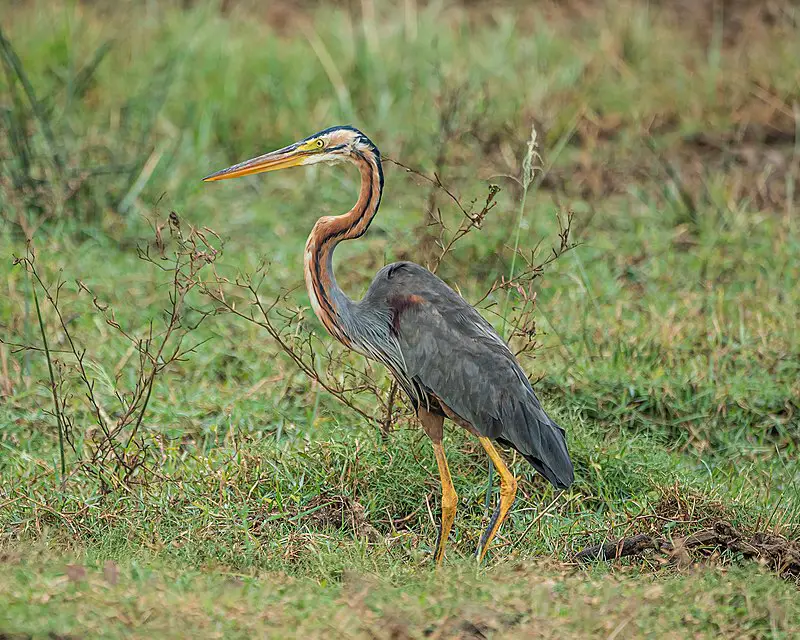
The Purple Heron is a majestic wading bird from the heron family which can be found in Africa, central and southern Europe, as well as southern and eastern Asia.
It has an impressive wingspan of up to 1.2 meters and its plumage usually ranges from grey-blue to purple on its back with brown streaks on it’s chest.
This species breeds during summer months before migrating for winter habitats where they feed mainly on fish or frogs near wetlands or rivers.
The scientific name Ardea purpureus originates from Latin words meaning ‘heron’ and ‘coloured purple’ respectively – referring to this bird’s beautiful colouration.
Scientific classification:
| Kingdom | Animalia |
| Phylum | Chordata |
| Class | Aves |
| Order | Pelecaniformes |
| Family | Ardeidae |
| Genus | Ardea |
| Species | A. purpurea |
28. Lesser Spotted Woodpecker
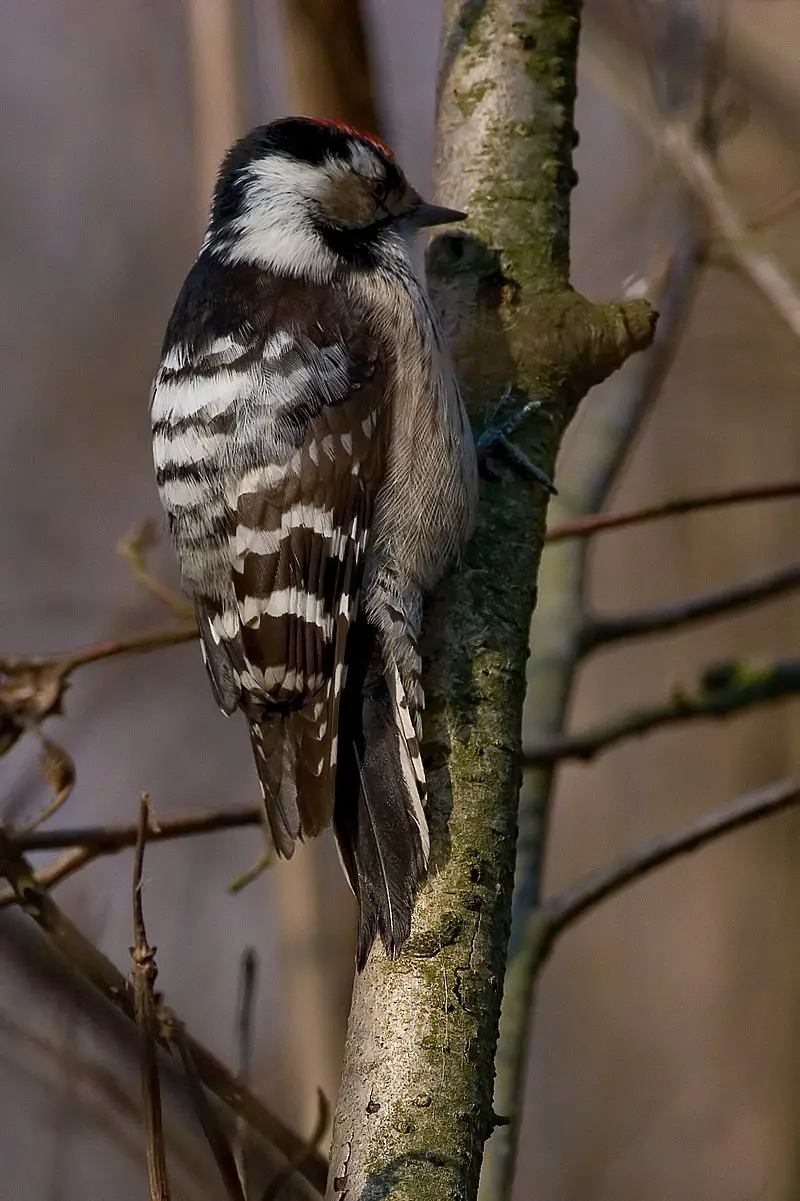
The Lesser Spotted Woodpecker (Dryobates minor) is a small, attractive bird belonging to the woodpecker family Picidae.
It is found in much of Europe and parts of Asia.
The species was previously classified under the genus Dendrocopos but has now been reassigned to Dryobates.
This beautiful little bird is characterized by its brown body with black wings, tail and head.
Its belly and throat are white while there are red patches on both sides of its neck-collar region. In addition, it also possesses yellowish stripes near its eyes that make it look quite smart.
The lesser spotted woodpeckers feed mainly on insects such as ants and beetles which they find beneath tree bark or among dead leaves.
They can be seen foraging alone or in pairs since they prefer living an isolated life away from human settlements.
Thus if you ever wish to spot one remember not to disturb them during their search for food else you might miss out this amazing opportunity.
Scientific classification:
| Kingdom | Animalia |
| Phylum | Chordata |
| Class | Aves |
| Order | Piciformes |
| Family | Picidae |
| Genus | Dryobates |
| Species | D. minor |
29. Common Chaffinch

The Common Chaffinch is a beautifully coloured small passerine bird belonging to the finch family.
The males have striking blue-grey caps and rust-red underparts, while the females are more subtle in their colouring but both possess two distinct white wing bars and white sides on their tails.
This gorgeous bird has an incredibly strong voice which can be heard for miles as it sings from exposed perches during mating season.
It lives mainly throughout Europe but also in parts of North Africa and Asia too, favouring woodland areas with plenty of shrubs or trees nearby where they find shelter amongst foliage when needed.
They feed predominantly on seeds from weeds or grains found within grasslands making them particularly useful birds for farmers who rely heavily upon pest control that these little ones provide.
Scientific classification:
| Kingdom | Animalia |
| Phylum | Chordata |
| Class | Aves |
| Order | Passeriformes |
| Family | Fringillidae |
| Subfamily | Fringillinae |
| Genus | Fringilla |
| Species | F. coelebs |
30. Whiskered Tern
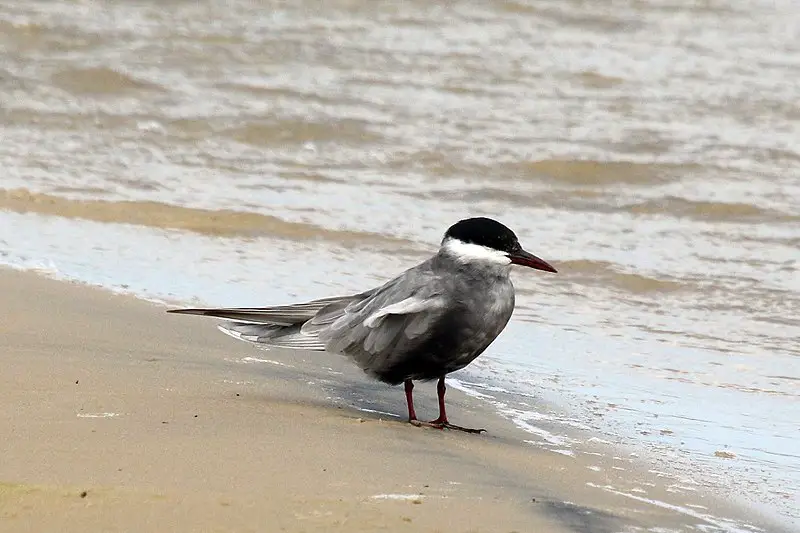
The whiskered tern (Chlidonias hybrida) is a small, graceful bird belonging to the family Laridae, which includes gulls, terns, and skimmers.
This bird is widely distributed across Europe, Asia, and Africa, where it breeds in colonies in freshwater marshes, ponds, and lakeshores.
The whiskered tern has a distinctive appearance, resembling a swallow, with a short, forked tail, black cap, and white cheeks.
One of the most distinctive features of the whiskered tern is its bill, which is strong and pointed. This adaptation allows it to catch insects and small fish, which make up the bulk of its diet.
During the breeding season, the whiskered tern’s bill and legs turn bright red, adding to its striking appearance.
The whiskered tern is a highly adaptable bird, and as such, it is found in various races across its range. For example, in Europe, it breeds mainly in western and southern countries, while in Asia, it breeds from the Middle East to the Russian Far East.
The whiskered tern is also a migrant bird, with populations wintering in sub-Saharan Africa, India, Southeast Asia, and Australia.
Breeding season for the whiskered tern is between May and August, and the birds form colonies with hundreds or thousands of individuals. They build their nests on floating vegetation or on the ground, and both sexes share incubation duties.
The chicks hatch after about three weeks, and the parents feed them insects and small fish until they are ready to fly after about three more weeks.
Although the whiskered tern is not considered threatened, its populations have declined in some areas, primarily due to habitat loss and degradation.
The destruction of wetlands, pollution, and changes in water levels and quality have all had an impact on the bird’s breeding and feeding grounds.
Scientific classification:
| Kingdom | Animalia |
| Phylum | Chordata |
| Class | Aves |
| Order | Charadriiformes |
| Family | Laridae |
| Genus | Chlidonias |
| Species | C. hybrida |
31. European Turtle Dove
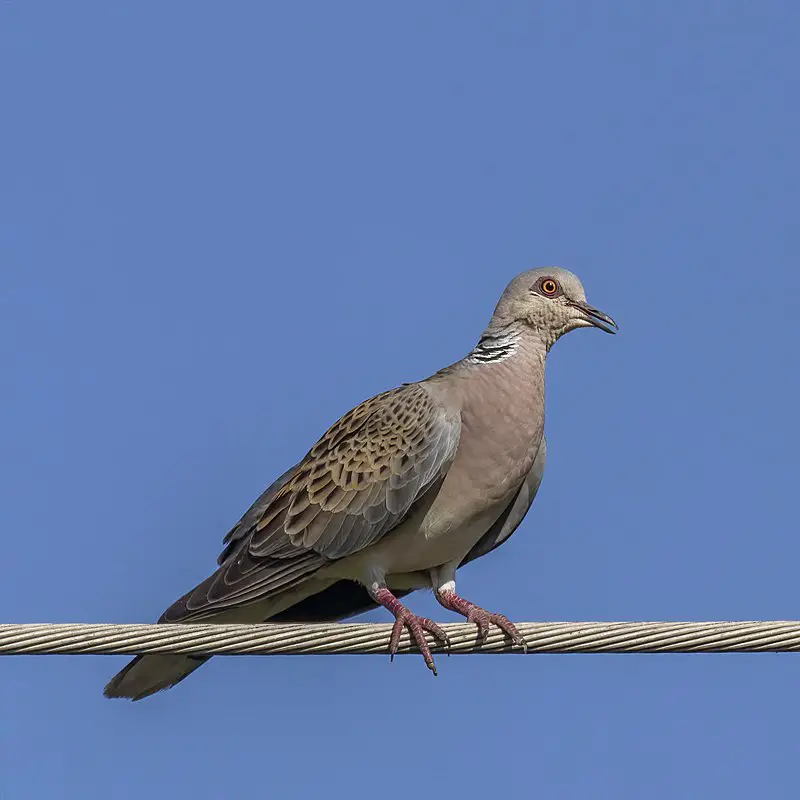
The European turtle dove is a beautiful bird belonging to the Columbidae family of doves and pigeons. It has a wide range across south western Palearctic, including northern Africa, but migrates to sub-Saharan Africa in winter.
The species was officially described by Carl Linnaeus in 1758 as part of his Systema Naturae. This small yet elegant creature can be recognized by its distinctive reddish-brown color with black spots on its wings and tail feathers.
Its underparts are yellowish white while it’s back is grey with dark streaks that run through it making for an attractive patterned plumage.
They feed mainly on grains found on grasslands or near roadsides and have a unique cooing call which makes them easily distinguishable amidst other birdsong.
Scientific classification:
| Kingdom | Animalia |
| Phylum | Chordata |
| Class | Aves |
| Order | Columbiformes |
| Family | Columbidae |
| Genus | Streptopelia |
| Species | S. turtur |
32. Sandwich Tern
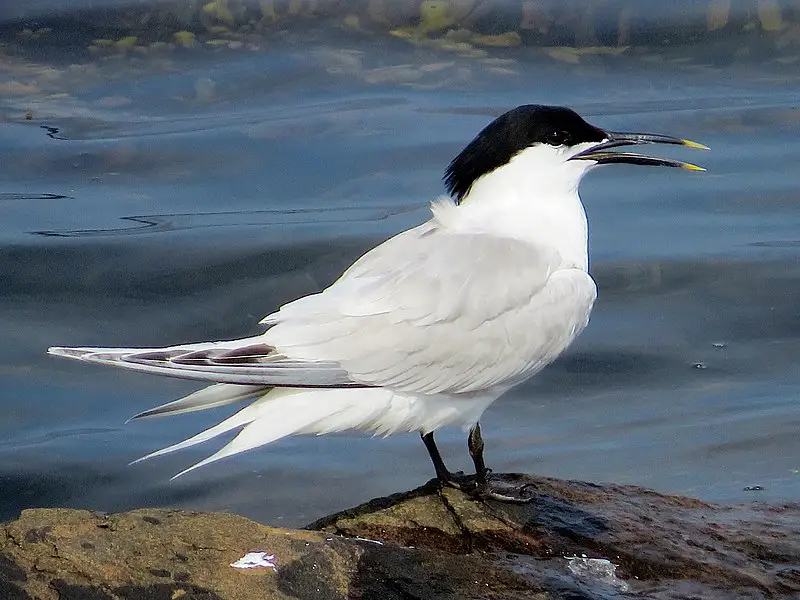
The Sandwich Tern is a medium-sized tern species belonging to the family Laridae. It has close relationships with four other crested terns, and is known to interbreed with the lesser crested.
These birds are distributed throughout Europe and as far east as Caspian Sea in summer, while they migrate south during winter season up to South Africa and India.
They have long wings which help them fly over vast distances effortlessly.
The plumage of these birds consists mainly of greyish tones on its body combined with white head and neck area; whereas it also sports an orange beak along black markings near their eyes – giving them a distinct look from other related species.
Scientific classification:
| Kingdom | Animalia |
| Phylum | Chordata |
| Class | Aves |
| Order | Charadriiformes |
| Family | Laridae |
| Genus | Thalasseus |
| Species | T. sandvicensis |
33. Common Ringed Plover
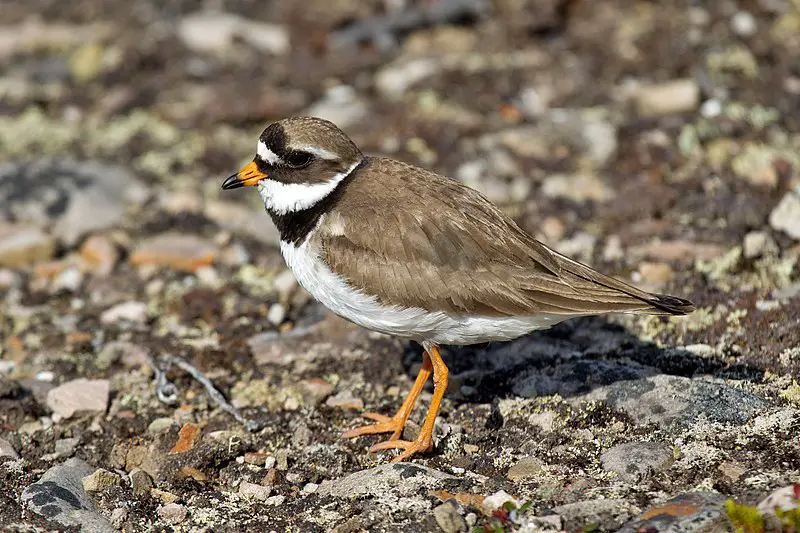
The Common Ringed Plover is a small migratory bird found in Arctic Eurasia. It has yellowish feathers and its Latin name, Charadrius hiaticula, means ‘bird of ravines’.
This species breeds on beaches and tundra during northern summer months before flying south when winter arrives.
Its diet consists mostly of insects which it catches by running along the shoreline or through shallow water with wings spread open to create a shadow that helps catch prey.
The common ringed plover nests in short grasses near water’s edge where they lay two eggs per clutch which hatch within three weeks.
These birds are highly territorial so will often defend their patch fiercely against competitors.
Scientific classification:
| Kingdom | Animalia |
| Phylum | Chordata |
| Class | Aves |
| Order | Charadriiformes |
| Family | Charadriidae |
| Genus | Charadrius |
| Species | C. hiaticula |
34. Green Sandpiper
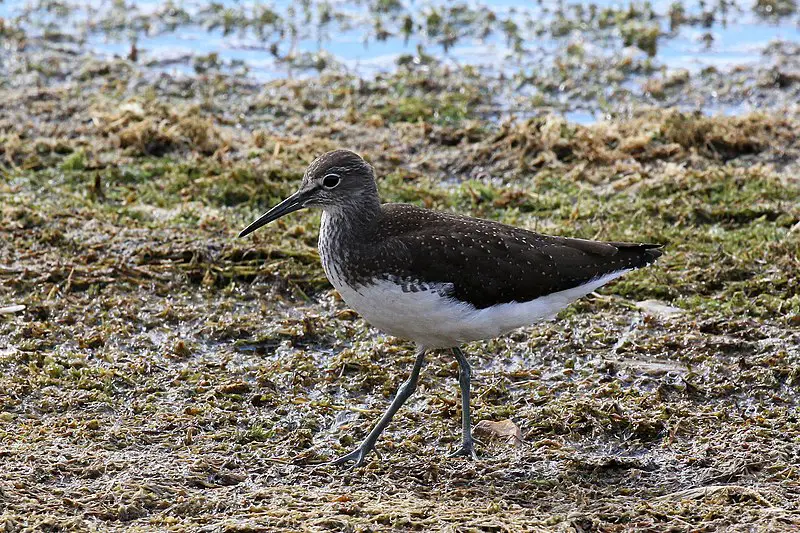
The Green sandpiper is a small Old World wader with distinctive brown wings dotted with light spots. Its neck and chest have a delicate but contrasting pattern that sets it apart from other shorebirds of its kind.
It belongs to an ancient lineage within the genus Tringa, closely related to the solitary sandpiper (Tringa solitaria).
What’s unique about these birds is their nesting habits; they nest in trees instead of on the ground like most scolopacids do.
This species can be found near bodies of water such as lakes, rivers or streams and are known for being fast fliers.
The green sandpiper makes up one part of our diverse avian population – it’s definitely worth learning more about.
Scientific classification:
| Kingdom | Animalia |
| Phylum | Chordata |
| Class | Aves |
| Order | Charadriiformes |
| Family | Scolopacidae |
| Genus | Tringa |
| Species | T. ochropus |
Also Featured In: Common Estonian Birds, Common Birds in London
35. European Shag
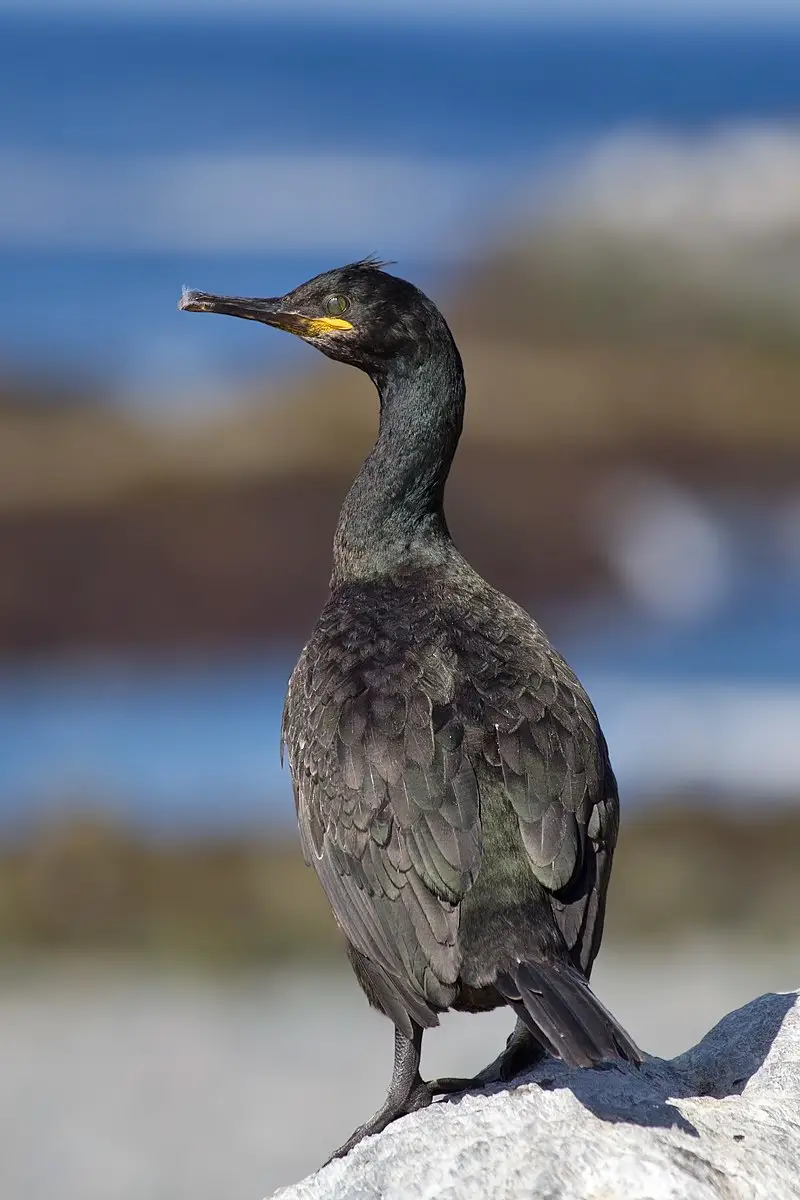
The European shag, or common shag, is a species of cormorant found in western and southern Europe, southwest Asia and north Africa. It usually winters in its breeding range except for the northernmost birds.
The bird has an unmistakable look with it’s greenish blue feathers on top of its head while having white underparts along with some black stripes over them.
Its long neck helps distinguish it from other cormorants as well as provide great sight while searching for food beneath the sea surface.
This seabird mainly feeds off fish but also eats crustaceans occasionally when available near their nesting grounds which are usually located around rocky coastlines close to open water bodies like seas and oceans.
Scientific classification:
| Kingdom | Animalia |
| Phylum | Chordata |
| Class | Aves |
| Order | Suliformes |
| Family | Phalacrocoracidae |
| Genus | Gulosus Montagu, 1813 |
| Species | G. aristotelis |
Also Featured In: Shetland Islands Birds You Should Know, Birds of Orkney
36. Little Ringed Plover
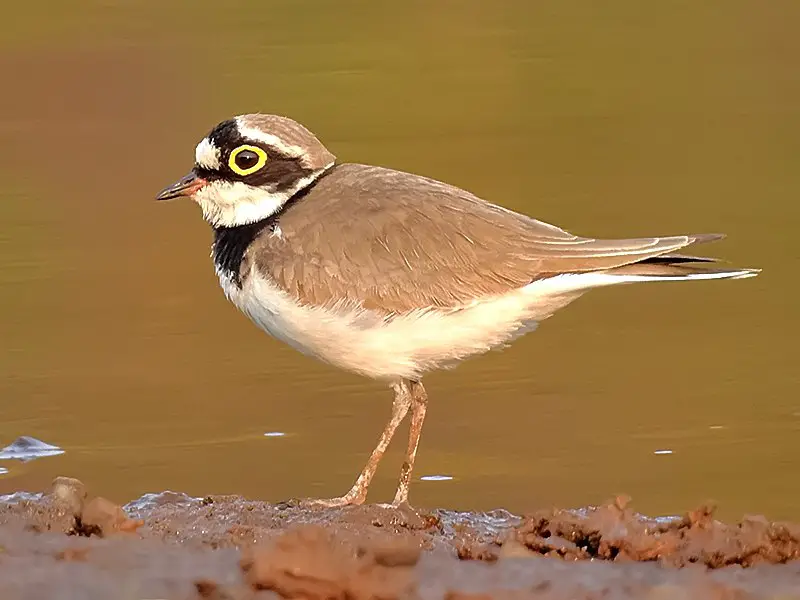
The Little ringed plover is a small species of bird from the genus Charadrius. It has been given its scientific name due to an uncertain origin and yellowish colouring, which was first noted in the fourth century Vulgate Bible.
Native to river valleys across Europe and parts of Asia, this wader prefers areas with soft ground where it can feed on insects or worms.
Its plumage consists mainly of brown tones but during breeding season males will develop a black breast band for courtship displays.
These birds construct shallow nests near waterbodies using pebbles found nearby as well as vegetation such as grasses and mosses to provide camouflage from predators.
The female typically lays three eggs at one time that are incubated by both parents until they hatch after around three weeks before fledging shortly afterwards.
Scientific classification:
| Kingdom | Animalia |
| Phylum | Chordata |
| Class | Aves |
| Order | Charadriiformes |
| Family | Charadriidae |
| Genus | Charadrius |
| Species | C. dubius |
37. Ruff
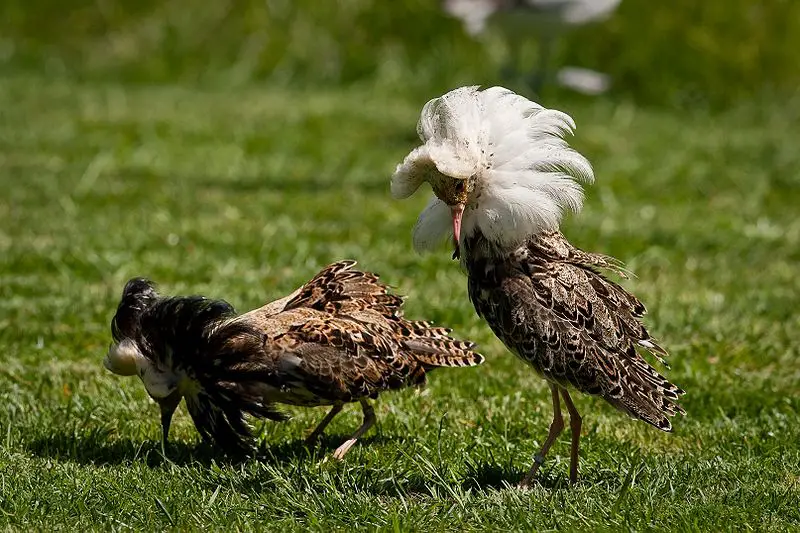
The Ruff is a medium-sized wading bird found in wetlands across northern Eurasia. It has an unmistakable appearance, with its long neck and pot belly body combined with bright plumage of males contrasting the duller browns of females.
During breeding season, males have unique feathers that form a ruff around their head which gave them their name.
This species displays sexual dimorphism; male Ruffs are much more colourful than female counterparts and they also develop longer bills during mating season to show off to potential mates.
Migratory by nature, huge flocks can be seen on winter grounds like Europe, Africa, Asia and Australia before returning back north for summer months when food sources become abundant again.
Scientific classification:
| Kingdom | Animalia |
| Phylum | Chordata |
| Class | Aves |
| Order | Charadriiformes |
| Family | Scolopacidae |
| Genus | Calidris |
| Species | C. pugnax |
38. Great Skua
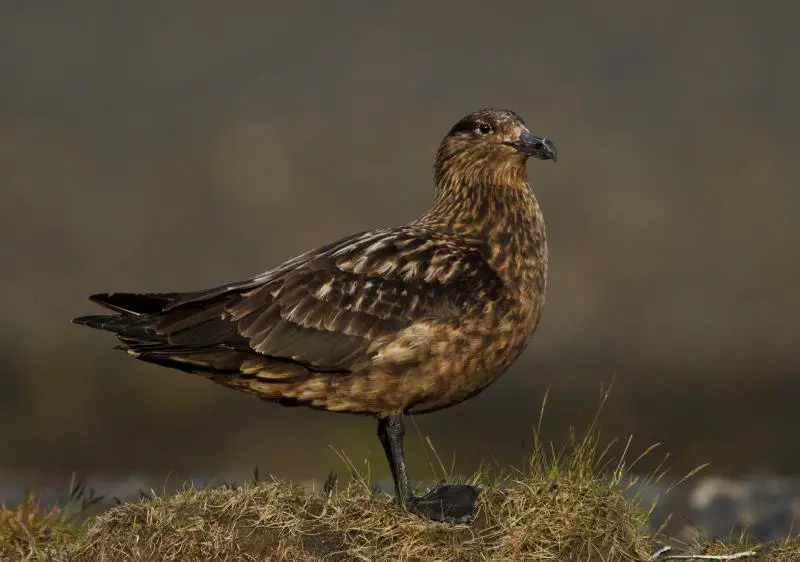
The Great Skua is a large sea bird belonging to the family Stercorariidae, found in areas such as Faroe Islands and Iceland.
It has a size similar to that of herring gulls, with its diet consisting mainly of fish caught at the surface or taken from other birds.
This species was first described by Danish zoologist Morten Thrane Brünnich in 1764 under the name Cath.
They are powerful predators who will sometimes use mobbing tactics against larger prey like gannets and eiders until they give up their catch.
These birds mate for life but may build nests near colonies if there aren’t enough suitable territories available on their own island range.
Although these skuas might seem intimidating due to their fierce nature when protecting young, they can be quite timid around humans so should not be approached too closely.
Scientific classification:
| Kingdom | Animalia |
| Phylum | Chordata |
| Class | Aves |
| Order | Charadriiformes |
| Family | Stercorariidae |
| Genus | Stercorarius |
| Species | S. skua |
39. Pallid Swift
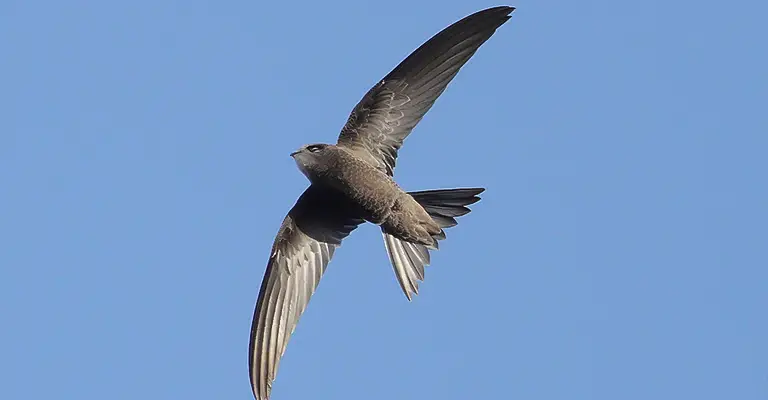
The Pallid Swift is a small bird that looks similar to the barn swallow or house martin, but it belongs to an entirely different order of birds.
This similarity in appearance is due to convergent evolution, which reflects their shared lifestyles.
These swifts have very short legs used only for clinging onto vertical surfaces such as walls and trees.
They are mostly found flying over open countryside during migration season and they feed on insects while in flight.
The feathers of this species range from greyish-brown above with white patches along its wings and tail, while beneath the body usually appears pale yellowish-white.
While these birds can be quite noisy when around roosting sites, they tend to remain silent when migrating through areas where humans live.
Scientific classification:
| Kingdom | Animalia |
| Phylum | Chordata |
| Class | Aves |
| Order | Apodiformes |
| Family | Apodidae |
| Genus | Apus |
| Species | A. pallidus |
Also Featured In: Common Birds in Tuscany, Most Common Birds of Sardinia
40. Ruddy Turnstone
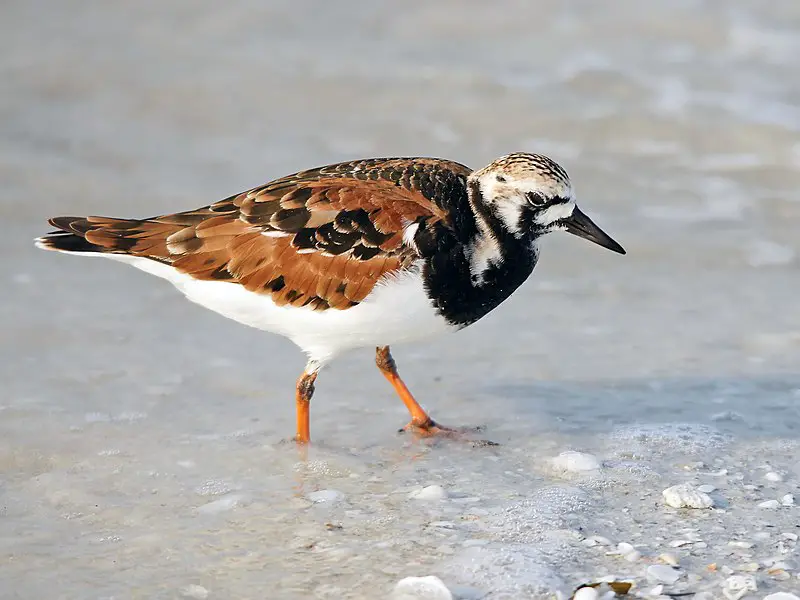
The Ruddy Turnstone is a small wading bird, belonging to the sandpiper family Scolopacidae. It has an attractive reddish-brown coloration and black patches on its back and wings.
This species breeds in northern parts of Eurasia and North America during summertime before migrating southwards in winter season to coastlines all over the world.
The Ruddy Turnstone feeds mainly on insects, mollusks, crustaceans, worms and some plant material such as seeds or berries which it finds by probing into mudflats with its bill.
It also uses stones for turning them when searching for food under rocks or pebbles along shorelines where they can often be seen darting around looking very busy.
Scientific classification:
| Kingdom | Animalia |
| Phylum | Chordata |
| Class | Aves |
| Order | Charadriiformes |
| Family | Scolopacidae |
| Genus | Arenaria |
| Species | A. interpres |
41. Kentish Plover
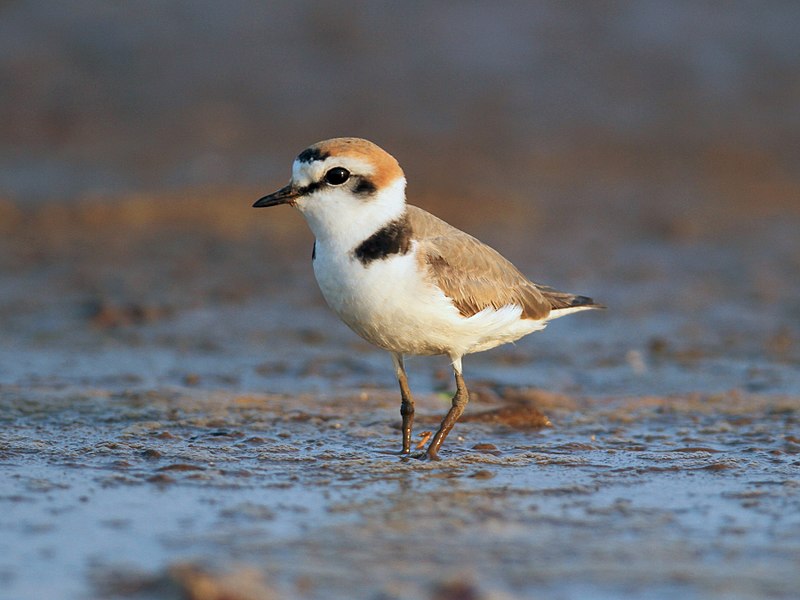
The Kentish plover is an elegant shorebird found around the world in coastal areas, saline lakes and lagoons. Both males and females have pale plumages with a white underside, grey/brown back, dark legs and a black bill.
The male birds however feature one extra distinction; they sport chestnut crowns on their heads.
During mating season the males are known to perform elaborate courtship displays – flying up high into the air before diving rapidly towards its partner while singing loudly.
They can be seen nesting among rocks or sand dunes close to water bodies where they use broken shells as building material for their nests.
This species of bird provides many benefits including controlling insect populations near coasts as well as providing food sources for larger predators such as raptors during migration times when prey is scarce.
Scientific classification:
| Kingdom | Animalia |
| Phylum | Chordata |
| Class | Aves |
| Order | Charadriiformes |
| Family | Charadriidae |
| Genus | Charadrius |
| Species | C. alexandrinus |
42. European Greenfinch
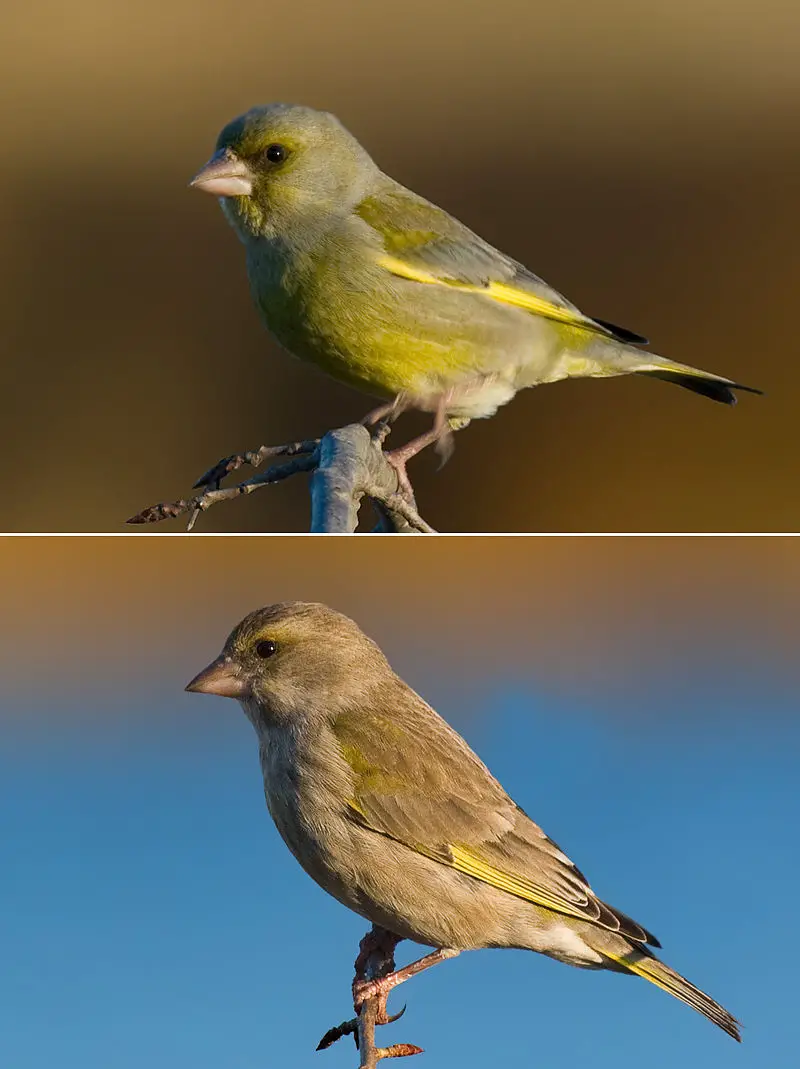
The European Greenfinch is a small, passerine bird from the finch family Fringillidae. It can be found throughout Europe, North Africa and Southwest Asia.
Some of its northernmost populations migrate further south during winter for warmer climates.
The species has been introduced to Australia, New Zealand, Uruguay and Argentina as well with great success in these new environments.
It was first described scientifically by Carl Linnaeus back in 1758 who noted its bright green feathers along with yellow edges on the wings and tail which make it an unmistakable sight when seen up close or at a distance while flying through open grasslands or wooded areas where they are known to feed on insects and seeds alike making them highly adaptable birds that find food sources easily wherever they go.
Scientific classification:
| Kingdom | Animalia |
| Phylum | Chordata |
| Class | Aves |
| Order | Passeriformes |
| Family | Fringillidae |
| Subfamily | Carduelinae |
| Genus | Chloris |
| Species | C. chloris |
43. Swifts
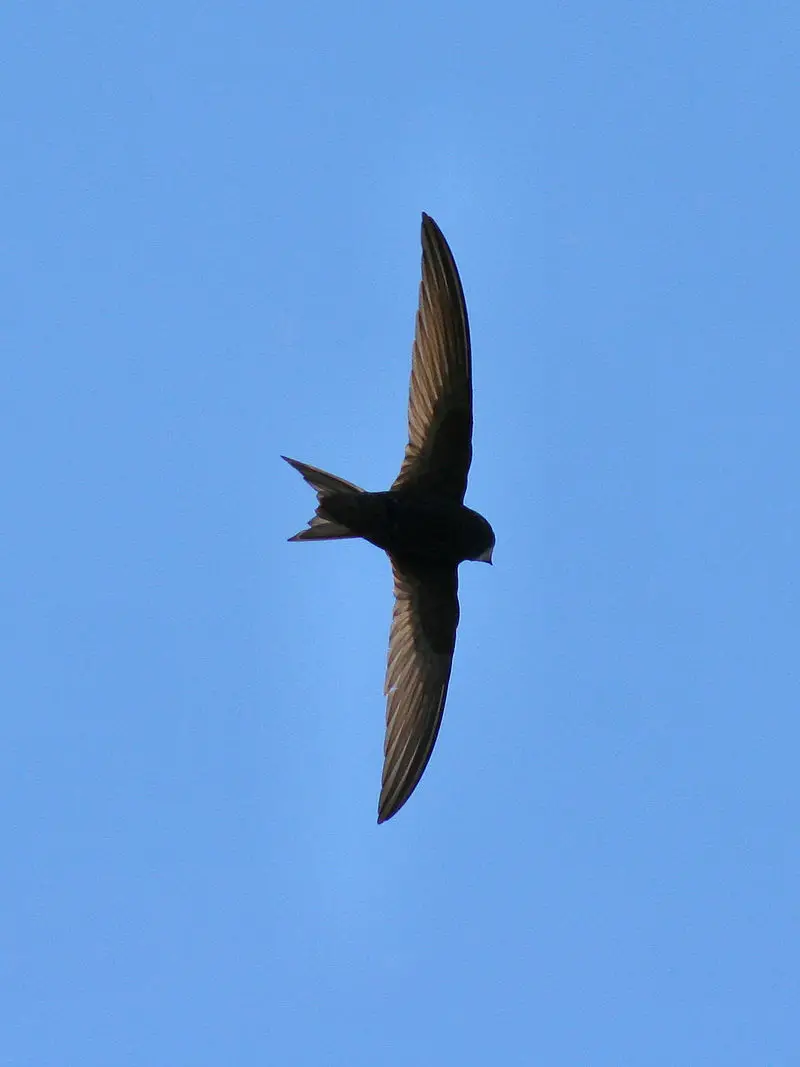
Swifts are small, aerial birds that belong to the Apodidae family. They look similar to swallows but they aren’t related in any way.
Swifts have evolved differently from other passerines and instead share an order with hummingbirds – the Apodiformes.
The Hemiprocnidae also shares a close relationship with swifts, being referred to as ‘treeswift’ due to their affinity for perching on trees rather than flying through the air like regular swifts do.
While these two species may appear quite similar at first glance, closer inspection will reveal vast differences between them which has come about over time via convergent evolution.
Scientific classification:
| Kingdom | Animalia |
| Phylum | Chordata |
| Class | Aves |
| Order | Apodiformes |
| Family | Apodidae Hartert, 1897 |
44. Bustard
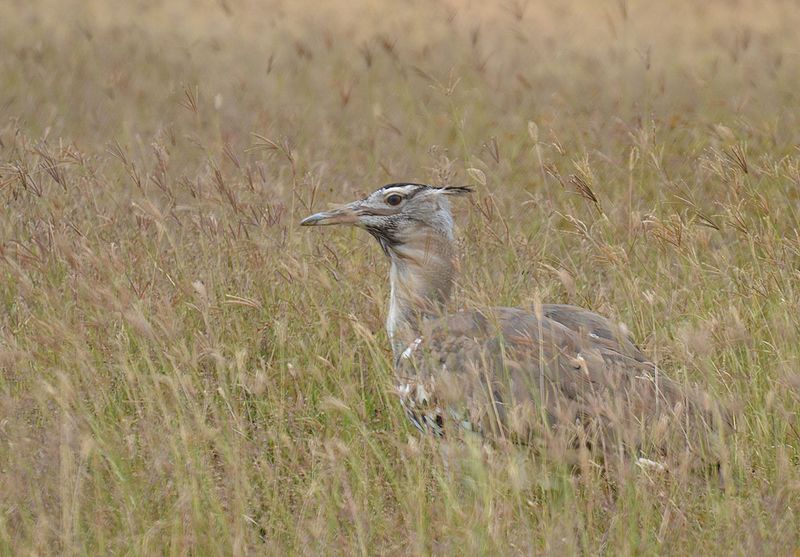
Bustards are large, terrestrial birds that inhabit dry grassland areas and the steppes of the Old World. They range from 40-150 cm in length and belong to the family Otididae.
Bustards have an omnivorous diet consisting of leaves, buds, seeds, fruit as well as small vertebrates and invertebrates.
These birds usually live a solitary life but can be seen gathering around water sources or food during certain times of year such as mating season.
Due to their large size they are vulnerable to predation by foxes or other animals which is why they tend to remain alert at all times.
When in open spaces while relying on camouflage for protection against predators when out in tall vegetation coverings.
Scientific classification:
| Kingdom | Animalia |
| Phylum | Chordata |
| Class | Aves |
| Clade | Otidimorphae |
| Order | Otidiformes Wagler, 1830 |
| Family | Otididae Rafinesque, 1815 |
45. Great Tit
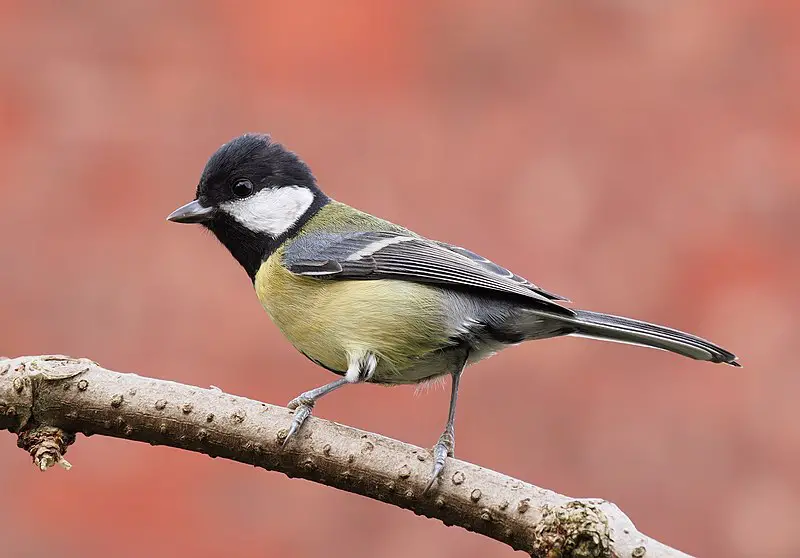
The Great Tit is a small passerine bird found in woodlands throughout Europe, the Middle East and Central Asia. Its beautiful black and white plumage with bold yellow or green patches make it easily distinguishable from other species of its family.
It generally does not migrate except for harsh winters but will stay resident in any kind of woodland area.
The diet consists mainly on insects, seeds and nuts which are found by searching through trees or scavenging from feeders placed near gardens.
Great Tits are also known to be clever problem solvers; they can open milk bottles left out unattended as well as cracking sunflower seeds that provide them essential nutrients during winter months when food is scarce.
Scientific classification:
| Kingdom | Animalia |
| Phylum | Chordata |
| Class | Aves |
| Order | Passeriformes |
| Family | Paridae |
| Genus | Parus |
| Species | P. major |
46. Northern Storm Petrels
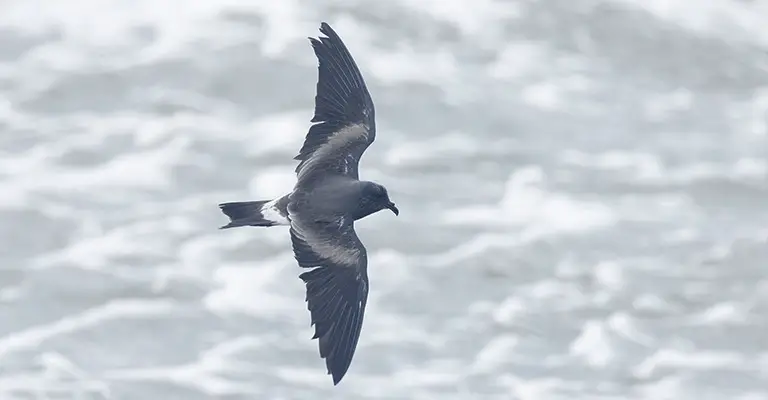
Northern storm petrels are one of the smallest seabirds, inhabiting oceans all over the world.
They have a unique ability to hover over water and pick planktonic crustaceans and small fish from the surface.
Northern storm petrels belong to the genus Hydrobates in family Hydrobatidae, part of Procellariiformes order.
This species was once lumped with austral storm petrel but recent studies show that they weren’t related closely which led them being split into two distinct species now.
These birds can be identified by their dark grey upperparts and wings along with white underparts when seen from afar while feeding on ocean’s surface.
Scientific classification:
| Kingdom | Animalia |
| Phylum | Chordata |
| Class | Aves |
| Order | Procellariiformes |
| Family | Hydrobatidae Mathews, 1912 |
| Genus | Hydrobates F. Boie, 1822 |
47. Eurasian Wryneck
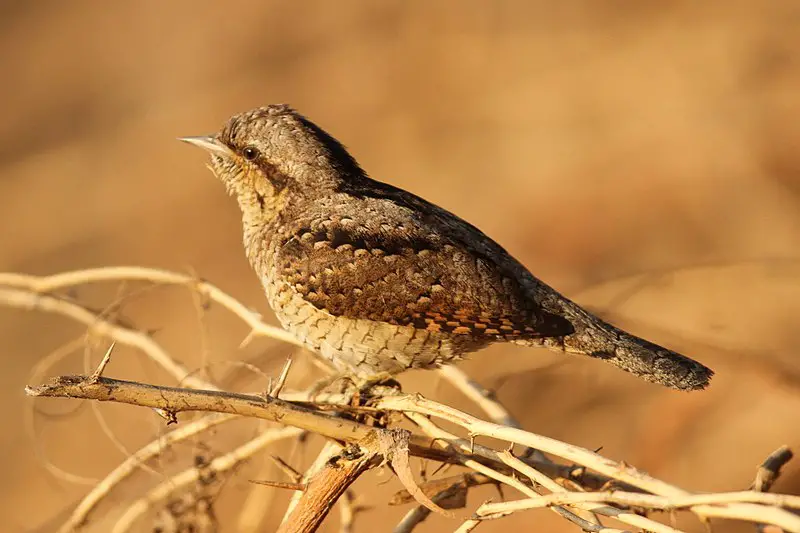
The Eurasian Wryneck is a species of woodpecker found in temperate regions of Europe and Asia. They breed during the summer months, but migrate south to tropical Africa or southern Asia for winter.
These birds are quite adaptable when it comes to their habitat, as they can be seen in open countryside, woodland, orchards and gardens alike.
To identify them you should look out for their distinctive brownish-grey feathers with black bars on the wings and tail; males also have red markings around their neck too.
Their diet consists mainly of insects which they find by probing into loose bark on trees or digging through soil with its sharp bill.
All in all an amazing bird that deserves more attention.
Scientific classification:
| Kingdom | Animalia |
| Phylum | Chordata |
| Class | Aves |
| Order | Piciformes |
| Family | Picidae |
| Genus | Jynx |
| Species | J. torquilla |
48. Lesser Black-Backed Gull
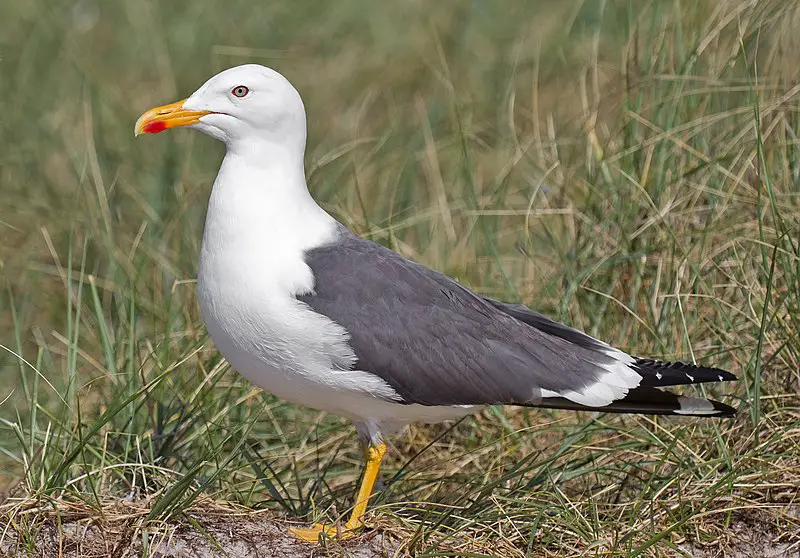
The lesser black-backed gull is a large, migratory bird found along the Atlantic coasts of Europe and North America.
During winter months they are commonly spotted along the British Isles to West Africa while in summer many birds can be seen year-round on both east and west coastlines.
In recent years numbers of these birds have risen dramatically with some winters having great abundances present throughout their range.
They measure around 48cm long with wingspans reaching up to 110 cm across when fully grown – making them larger than most other common gull species.
These hardy seabirds feed mainly on small fish, crustaceans, molluscs as well as carrion or scraps from human activities that occur near coastal areas such as fishing ports or refuse dumpsites.
Scientific classification:
| Kingdom | Animalia |
| Phylum | Chordata |
| Class | Aves |
| Order | Charadriiformes |
| Family | Laridae |
| Genus | Larus |
| Species | L. fuscus |
Also Featured In: Amsterdam Birds You Should Know, Birds of Farne Islands
49. Barn Swallow
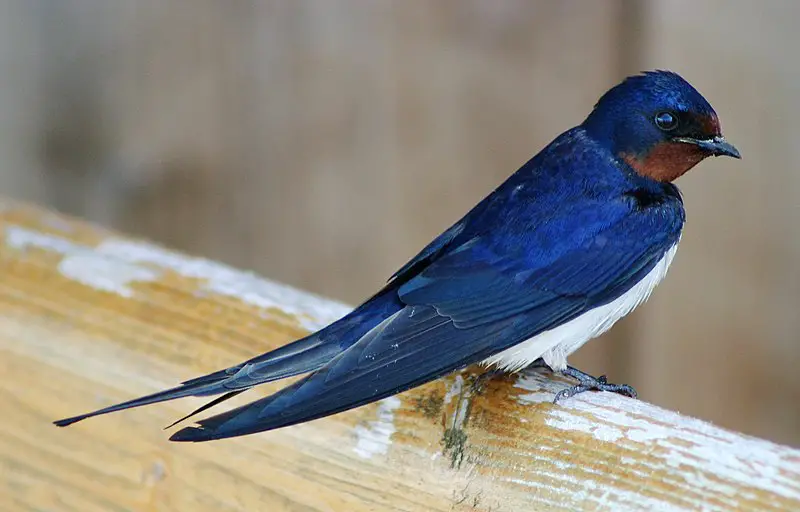
The Barn Swallow is a beautiful passerine bird with blue upperparts and a long, deeply forked tail. Found in Europe, Asia, Africa and the Americas.
It has an astonishingly large natural distribution spanning 251 million square kilometres globally; likely making it one of the world’s most widespread species.
This swallow typically nests near human habitation as well as other open areas such as fields or grasslands which provide them with suitable invertebrate prey to feed on.
They are insectivorous birds that often fly together in flocks looking for food over rivers or marshes usually just above tree-top level.
The barn swallow can also be identified by its strong flight consisting of swift continuous wing beats interspersed with glides during which they hold their wings slightly raised at the shoulders giving them distinct V shaped silhouettes in the sky.
Scientific classification:
| Kingdom | Animalia |
| Phylum | Chordata |
| Class | Aves |
| Order | Passeriformes |
| Family | Hirundinidae |
| Genus | Hirundo |
| Species | H. rustica |
50. Cinereous Vulture
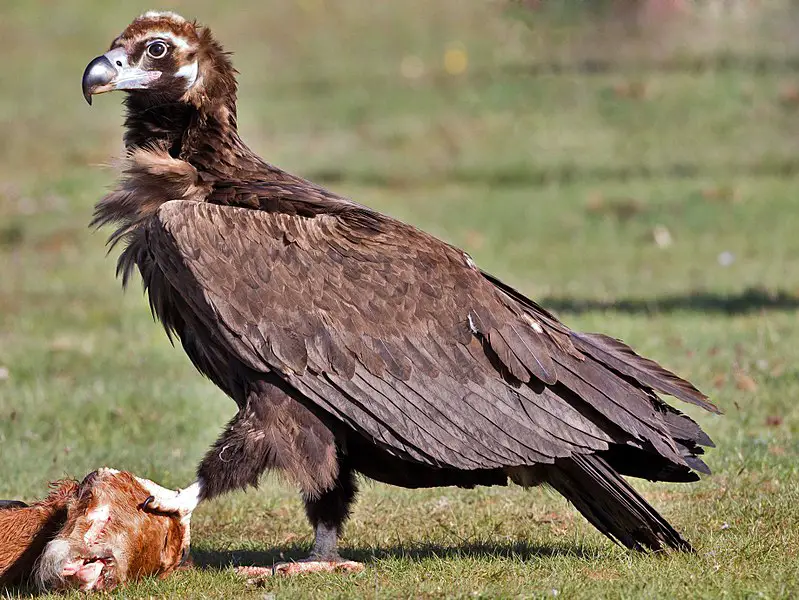
The cinereous vulture, also known as the black vulture, monk vulture and Eurasian black vuture is a large raptor found in temperate Eurasia. It has an impressive wingspan of 3.1 metres (10 feet) with a body length of 1.2 metres (3 ft 11in).
They are the largest Old World Vultures and can reach weights up to 14 kilograms(31 lbs).
Their diet consists mainly of carrion but they have been recorded taking live prey such as rodents or hares which allows them to search for food over wide areas quickly.
These birds usually hunt alone during daylight hours due their eyesight being well adapted at picking out carcasses from far away distances while soaring high in the sky above open grasslands or wooded hillsides where they breed seasonally between late winter and early autumn typically laying one egg per pair each year.
Scientific classification:
| Kingdom | Animalia |
| Phylum | Chordata |
| Class | Aves |
| Order | Accipitriformes |
| Family | Accipitridae |
| Genus | Aegypius |
| Species | A. monachus |
51. Gull-Billed Tern
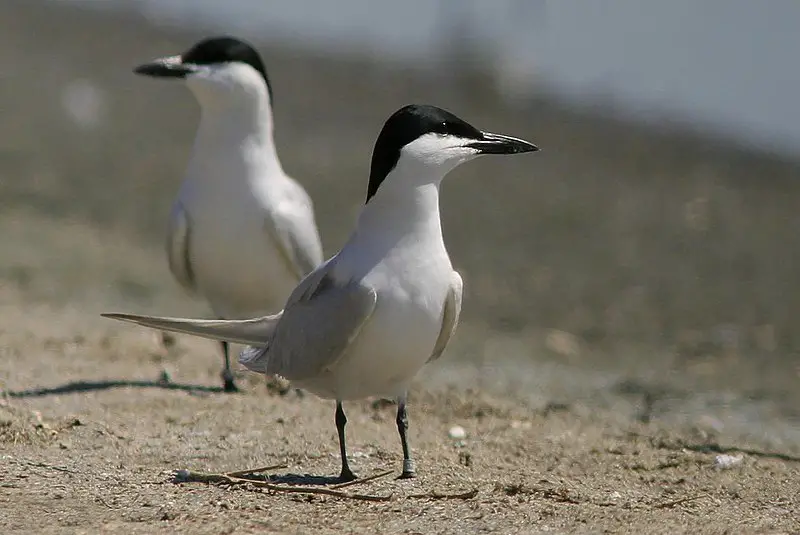
The Gull-billed Tern is a species of seabird from the Laridae family. It has an extensive range, breeding in parts of Europe, Asia, Northwest Africa and North America.
It was formally described by Johann Friedrich Gmelin in 1789 as Sterna nilotica before being reclassified to Gelochelidon nilotica.
The Australian subspecies was previously considered separate but now included with this species.
They are quite small birds measuring around 24 cm long with greyish brown upperparts throughout their body and white underneaths along with black legs and feet.
Their head also features a distinctive yellow bill which they use to hunt for fish on rivers or coasts near shallow waters where they tend to nest during summer months on ground level instead of trees like other terns do usually.
Scientific classification:
| Kingdom | Animalia |
| Phylum | Chordata |
| Class | Aves |
| Order | Charadriiformes |
| Family | Laridae |
| Genus | Gelochelidon |
| Species | G. nilotica |